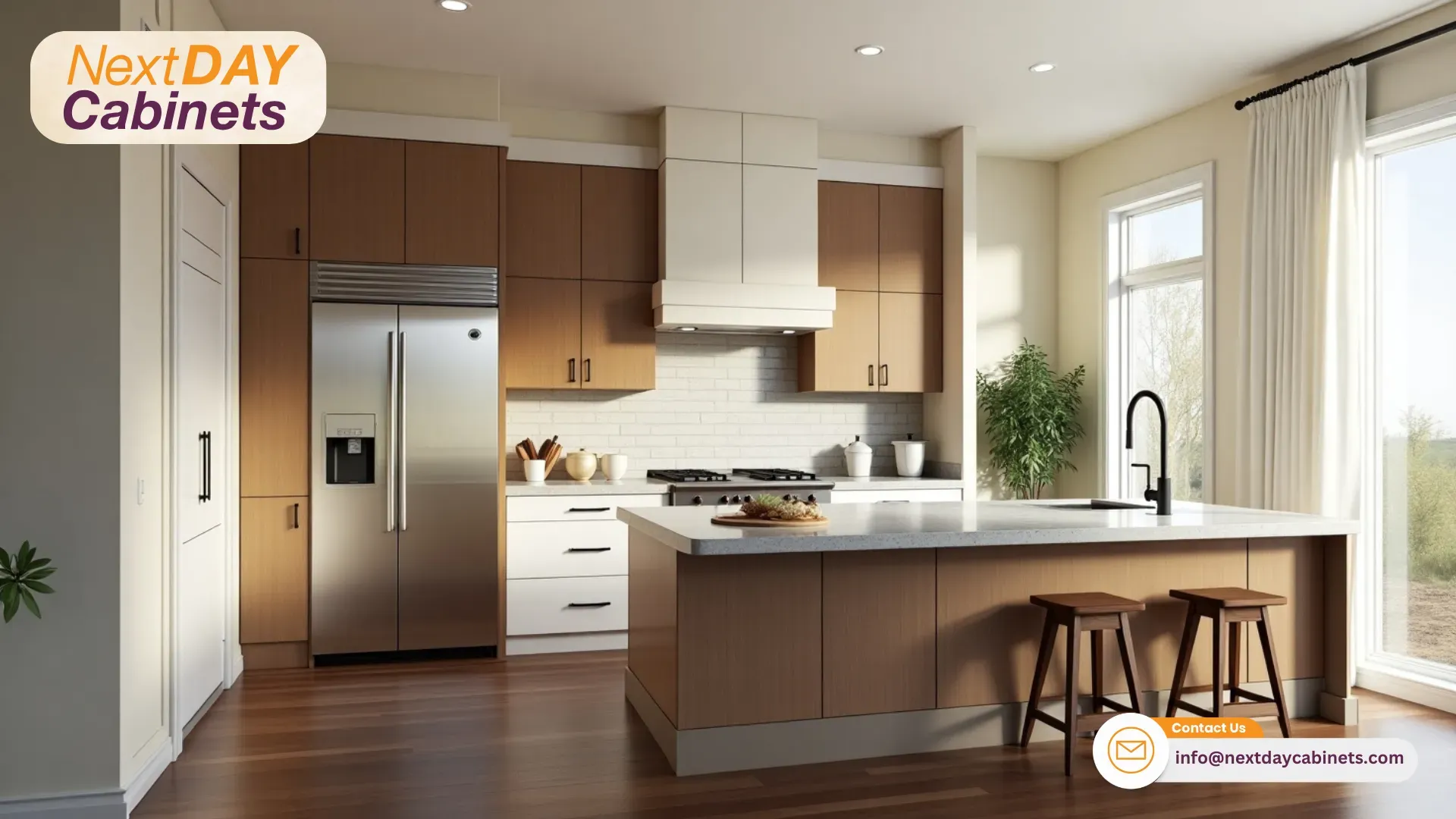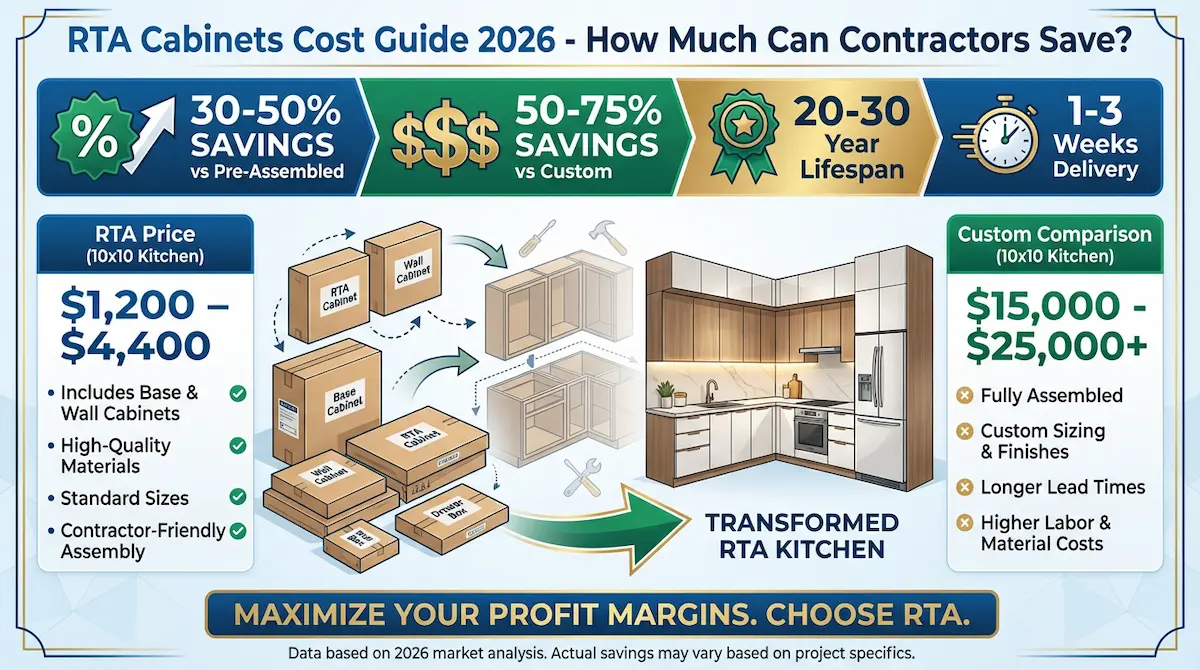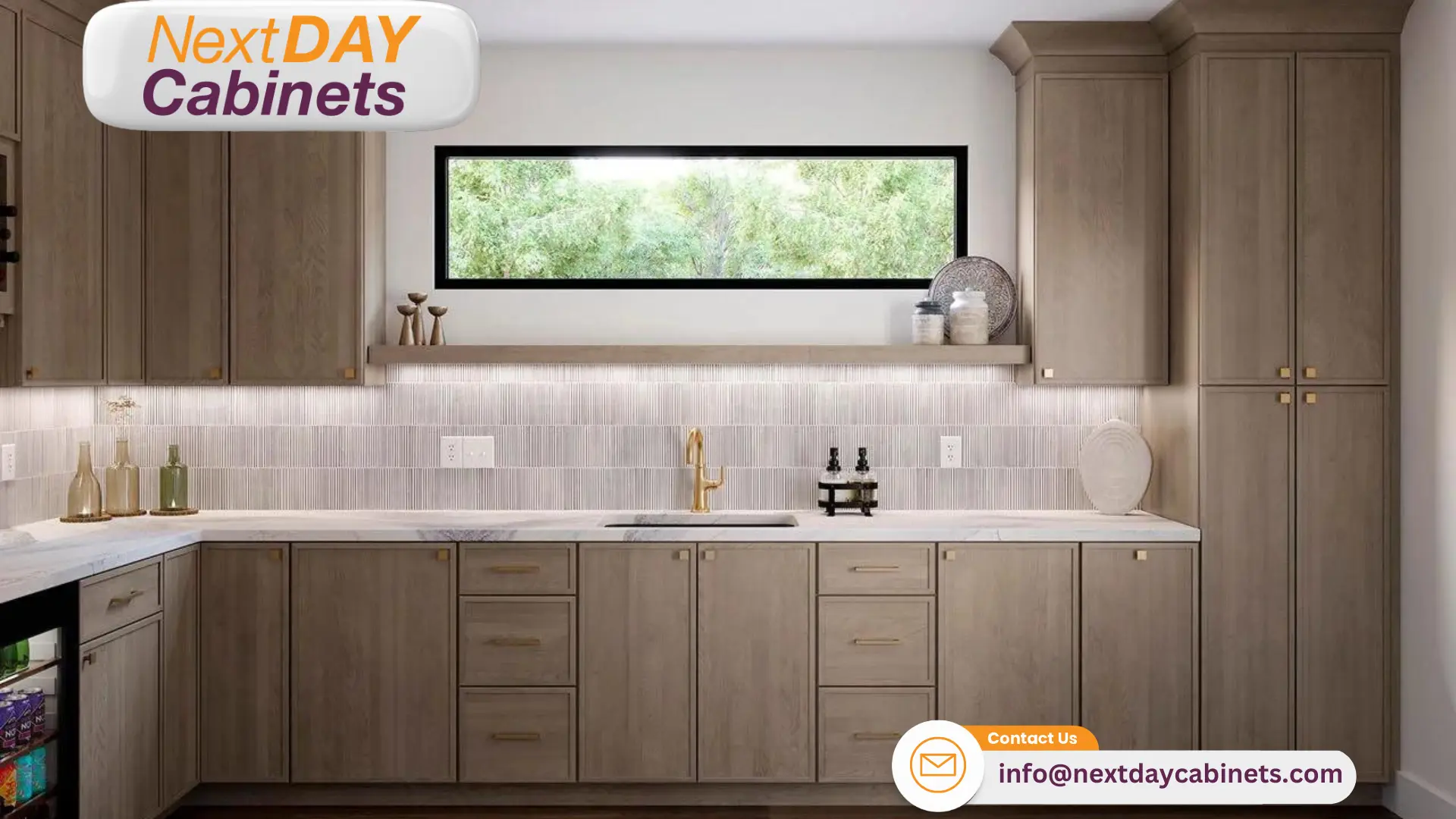
Choosing the Right Kitchen Cabinet Material: Top 8 Picks
Selecting the right kitchen cabinet material can significantly impact your home’s aesthetics and functionality. This guide will explore cabinet materials, from traditional solid wood to modern alternatives like laminate and metal.
We’ll discuss the pros and cons of each option, helping you make an informed decision that aligns with your style, budget, and maintenance preferences. Whether renovating your kitchen or building a new home, NextDAY Cabinets in Virginia offers a wide range of kitchen cabinets and bathroom vanities to suit your needs.

Key Takeaways for Choosing the Right Kitchen Cabinet Material: Top 8 Picks
- Durability and Budget: When selecting kitchen cabinet materials, prioritize durability and budget to ensure a long-lasting investment that meets your financial constraints.
- Engineered Wood Options: Consider modern alternatives like engineered wood and laminate, which provide cost-effective solutions without sacrificing performance.
- Eco-Friendly Choices: Sustainable materials such as bamboo and reclaimed wood are increasingly popular, offering aesthetic appeal and environmental benefits.
- Consult Design Experts: Engaging with design professionals can help homeowners avoid common mistakes and make informed decisions regarding cabinet materials.
- Innovative Materials: New technologies in cabinet materials are emerging, enhancing functionality and design possibilities for modern kitchens.
- Material Properties: Understanding the characteristics of various materials, such as plywood and MDF, is crucial for making informed choices based on heat and moisture resistance.
- Maintenance Considerations: Different materials require varying maintenance levels; solid wood may need periodic refinishing, while engineered options often offer lower upkeep.
- Aesthetic Compatibility: Ensure that the chosen cabinet material harmonizes with existing kitchen elements to maintain a cohesive design throughout the space.
- Trends for 2024: Current trends emphasize innovative, durable materials that integrate eco-friendliness and high-tech features, catering to modern consumer preferences.
- Long-Term Cost Efficiency: While lower-cost materials may be tempting, investing in higher-quality options can lead to better durability and lower overall costs in the long run due to reduced maintenance and replacement needs.
Understanding Kitchen Cabinet Materials: A Buyer’s Guide
Understanding kitchen cabinet materials is crucial for homeowners in Richmond, VA, to make informed decisions. This guide explores why material selection matters, providing an overview of standard options like stainless steel, thermofoil, and laminate NextDAY Cabinets. Key factors to consider when choosing cabinet materials will be discussed, helping homeowners select the best choice for their needs and preferences.
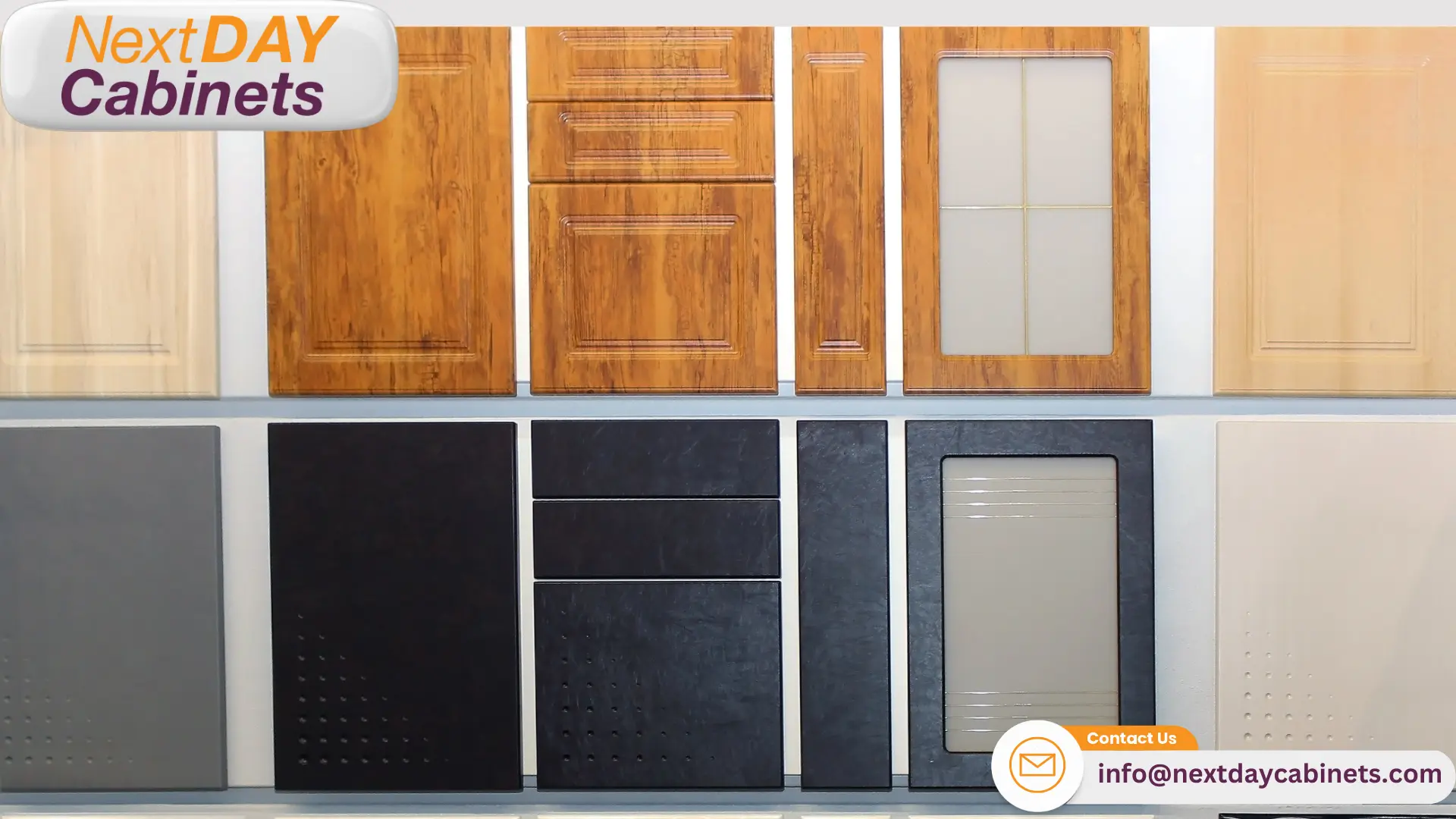
Why Material Matters in Kitchen Cabinetry
The choice of material for kitchen cabinets significantly impacts their durability, aesthetics, and performance. Plywood and MDF (Medium-Density Fiberboard) are two popular options, each with distinct characteristics that affect their resistance to heat and moisture in the kitchen environment. While plywood offers excellent strength and moisture resistance, MDF cabinets provide a smooth surface that is ideal for painting and is less prone to warping.
The material selection also influences the cabinet’s longevity and maintenance requirements. MDF, for instance, may be more susceptible to damage from excessive heat or moisture, making it crucial to consider the specific conditions of your kitchen. Understanding these material properties helps homeowners make informed decisions that balance their aesthetic preferences with practical considerations for their kitchen‘s daily use and long-term performance.
Overview of Common Kitchen Cabinet Materials
Kitchen cabinet materials vary widely, offering unique benefits for different needs and preferences. Hardwood cabinets, such as oak or maple, provide durability and a classic aesthetic while resisting water damage better than some alternatives. Laminate and thermofoil options offer cost-effective solutions with a wide range of color and finish choices, though they may be more susceptible to moisture-related issues.
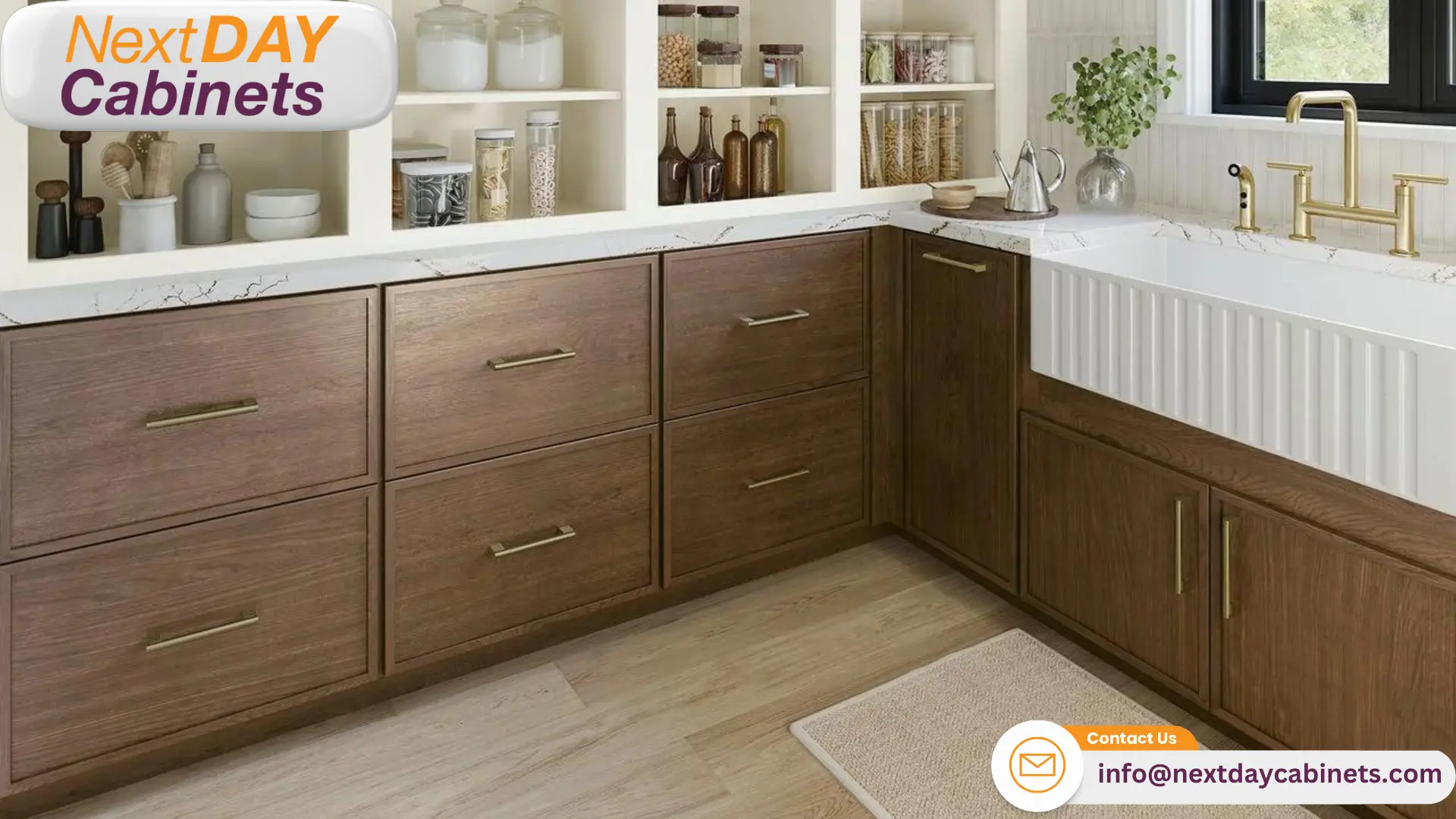
Stainless steel cabinets have gained popularity for their modern look and exceptional resistance to water and heat, making them ideal for areas near sinks or cooking surfaces. For those seeking a balance between durability and affordability, medium-density fiberboard (MDF) cabinets with a high-quality veneer or paint finish can provide a smooth, uniform appearance while offering moderate resistance to kitchen moisture and wear.
Key Factors to Consider When Selecting Cabinet Material
When selecting cabinet material, homeowners should consider durability, aesthetics, and maintenance requirements. Solid wood cabinetry offers timeless beauty and durability, while wood veneer provides a cost-effective alternative with a similar appearance. Fiberboard options, such as medium-density fiberboard (MDF), offer stability and a smooth surface for painting but may be less moisture-resistant than solid wood.
Budget constraints and environmental factors also play crucial roles in material selection. While solid wood cabinets may be more expensive upfront, their longevity can make them a cost-effective choice in the long run. Homeowners should also consider their kitchen‘s humidity levels and exposure to heat, as these factors can affect the performance of different wood and fiberboard materials in cabinetry.
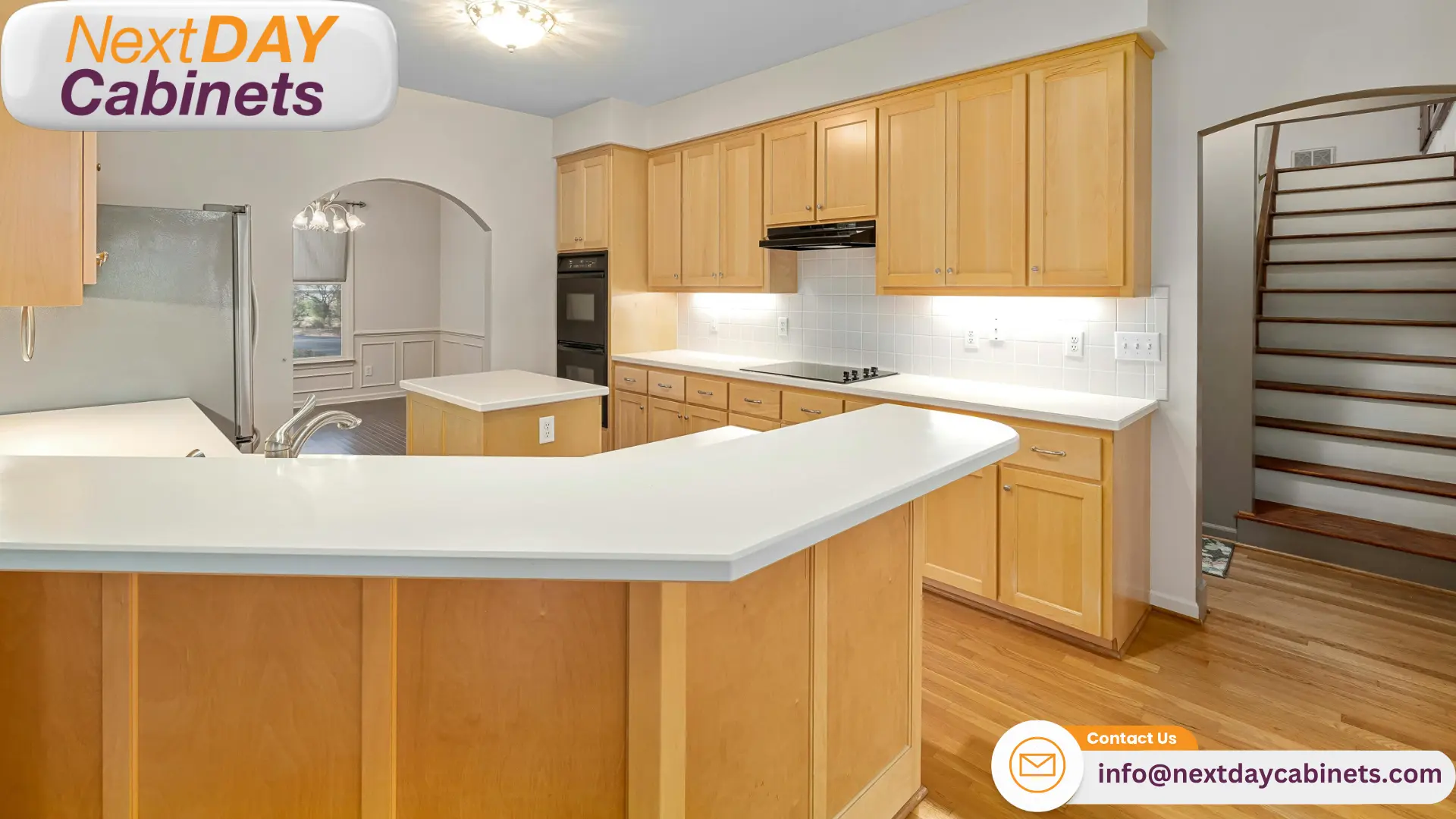
Solid Wood: Timeless and Traditional
Solid wood cabinets offer timeless appeal and durability, making them a popular choice for homeowners. This section explores the advantages of solid wood, different wood types, their characteristics, and maintenance tips for longevity. While solid wood is a traditional option, it’s essential to compare it with alternatives like engineered wood, plywood, particle board, and stainless steel to make an informed decision.
Advantages of Solid Wood Cabinets
Solid wood cabinets offer unparalleled durability and timeless aesthetic appeal, making them popular for kitchen and bathroom designs. Unlike thermofoil or melamine resin finishes, solid wood cabinets can be refinished or repaired, extending their lifespan and allowing homeowners to update their look without replacing the entire cabinet structure.
The natural beauty of solid wood grain patterns adds warmth and character to any space, complementing various design styles. Additionally, solid wood cabinets provide excellent structural integrity, supporting heavy countertops and withstanding daily use better than cabinets made with particle board or other engineered materials. This durability, combined with their ability to be customized through staining or painting, makes solid wood cabinets a versatile and long-lasting investment for homeowners:
| Feature | Benefit |
|---|---|
| Durability | Long-lasting, withstands daily use |
| Aesthetics | Natural grain patterns, timeless appeal |
| Customization | Can be refinished or repaired |
| Versatility | Suitable for various design styles |
Different Types of Wood and Their Characteristics
Different wood types offer unique characteristics for kitchen cabinets, influencing aesthetics, durability, and maintenance requirements. Oak provides a robust and distinctive grain pattern and excellent resistance to wear, making it ideal for high-traffic kitchens. With its delicate, uniform texture, Maple accepts paint and stain well, offering versatility in design. Cherry wood develops a rich, deep color over time, perfect for creating a warm, luxurious ambiance.
For those considering a renovation, birch presents an affordable option with a light color and subtle grain, suitable for various finishes, including paint. Walnut, though less common, offers a naturally dark, sophisticated look that complements modern kitchen designs. While not as traditional as wood, stainless steel cabinets provide unparalleled durability and a sleek, contemporary aesthetic, resistant to moisture and easy to clean. Some manufacturers also offer hybrid options, combining wood with resin or paper-based materials for enhanced durability:
| Wood Type | Characteristics | Best For |
|---|---|---|
| Oak | Strong, distinctive grain | High-traffic kitchens |
| Maple | Fine, uniform texture | Versatile designs |
| Cherry | Rich, deepening color | Warm, luxurious look |
| Birch | Light color, subtle grain | Affordable renovations |
| Walnut | Naturally dark, sophisticated | Modern designs |
Maintenance and Care for Longevity
Properly maintaining solid wood cabinets ensures their longevity and preserves their natural beauty. Regular cleaning with a soft, damp cloth and mild soap removes dirt and grime without damaging the wood grain. For maple cabinets, avoiding harsh chemicals and excessive moisture prevents warping and discoloration, maintaining the wood‘s integrity and appearance over time.
Periodic inspection of drawer construction and hardware helps identify potential issues early. Tightening loose screws and lubricating drawer slides prevents wear and ensures smooth operation. A quality wood conditioner annually nourishes the wood, preventing drying and cracking, especially in areas with fluctuating humidity. For cabinets with hardboard components, extra care should be taken to avoid prolonged exposure to moisture:
| Maintenance Task | Frequency | Purpose |
|---|---|---|
| Cleaning | Weekly | Remove dirt and grime |
| Hardware Inspection | Monthly | Prevent wear and ensure functionality |
| Wood Conditioning | Annually | Nourish wood and prevent drying |
| Finish Touch-up | As needed | Maintain appearance and protect wood |
Engineered Wood Options for Kitchen Cabinets
Engineered wood options offer diverse solutions for kitchen cabinets, balancing cost, durability, and aesthetics. Plywood provides strength and versatility, while Medium Density Fiberboard (MDF) offers a smooth surface at an economical price. Particleboard presents a budget-friendly option for basic cabinetry needs. These materials vary in resistance to humidity and moisture, impacting their suitability for different kitchen environments and furniture applications.
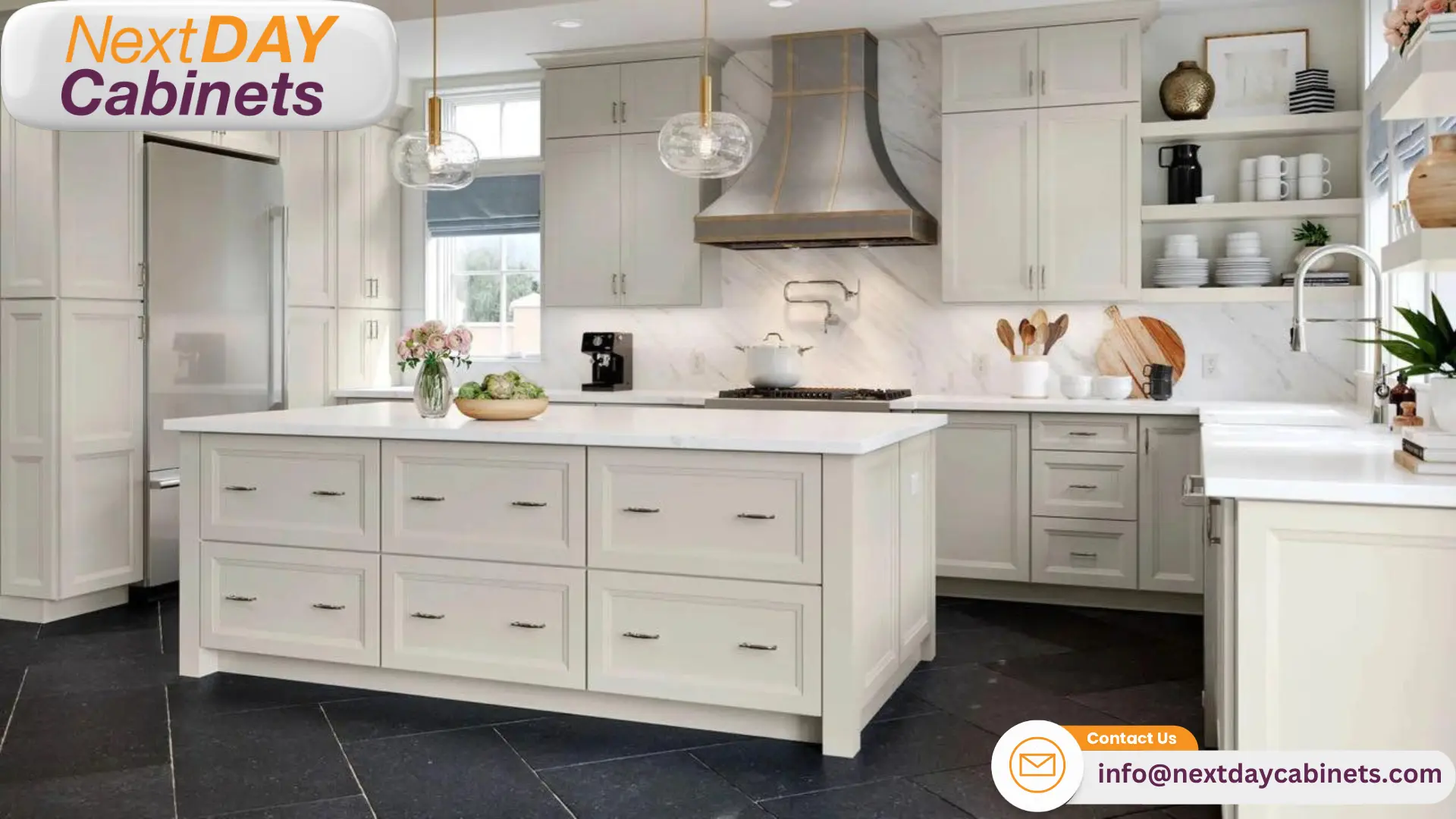
Plywood: Strength and Versatility
Plywood offers exceptional strength and versatility for kitchen cabinets, making it a popular choice among homeowners and builders. Its layered construction, consisting of thin wood veneers bonded together, provides superior resistance to warping and shrinking compared to solid wood. This engineered wood option combines the beauty of natural wood grain with enhanced durability, making it suitable for various cabinet styles, including those with oak finishes.
The versatility of plywood extends to its compatibility with different hardware options, allowing for easy installation of screws and hinges. Its structural integrity enables it to support heavy countertops and appliances effectively. Plywood‘s resistance to moisture also makes it an excellent choice for areas prone to humidity, outperforming materials like particle board or fiber-based alternatives. Consider the following advantages of plywood for kitchen cabinets:
- Superior strength and stability
- Resistance to warping and moisture
- Compatibility with various finishes and hardware
- Cost-effective alternative to solid wood
- Suitable for custom cabinet designs.
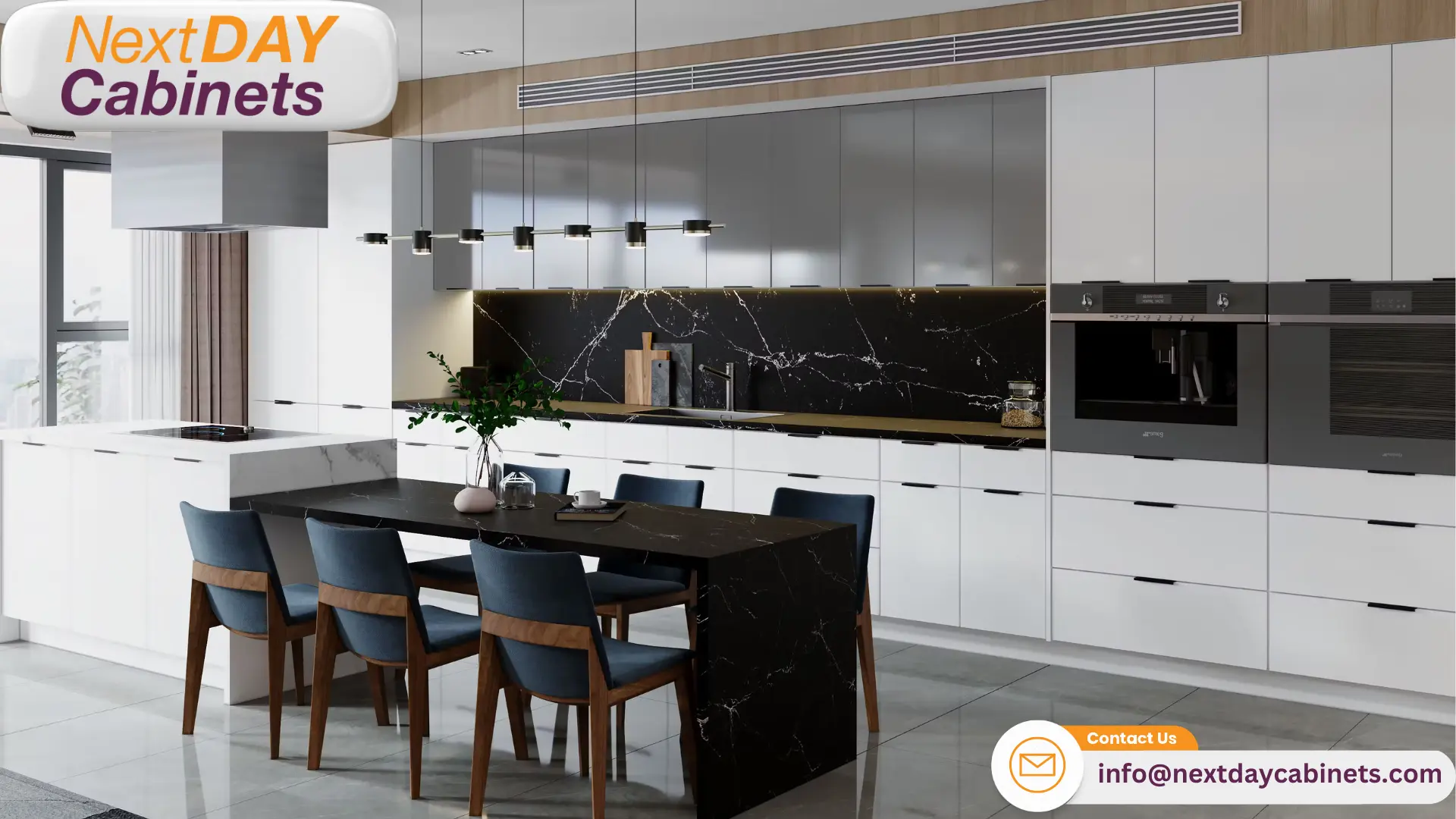
MDF (Medium Density Fiberboard): Smooth and Economical
Medium-density fiberboard (MDF) offers a smooth, uniform surface ideal for kitchen cabinets, mainly when aesthetics and cost-effectiveness are priorities. Its consistent density and lack of knots or grain patterns make it an excellent substrate for melamine or laminate finishes, allowing for a wide range of color and texture options. MDF‘s affordability and ease of machining make it a popular choice for homeowners seeking a sleek, modern look without the higher cost of solid wood or metal cabinets.
While MDF excels in providing a flawless surface for painted finishes, it requires careful consideration in high-moisture areas. Manufacturers often apply protective coatings or use moisture-resistant variants to enhance MDF‘s performance in kitchen spaces. The material’s uniform composition also allows for intricate designs and edge profiles, making it versatile for various cabinet styles and space-saving solutions in compact kitchens.
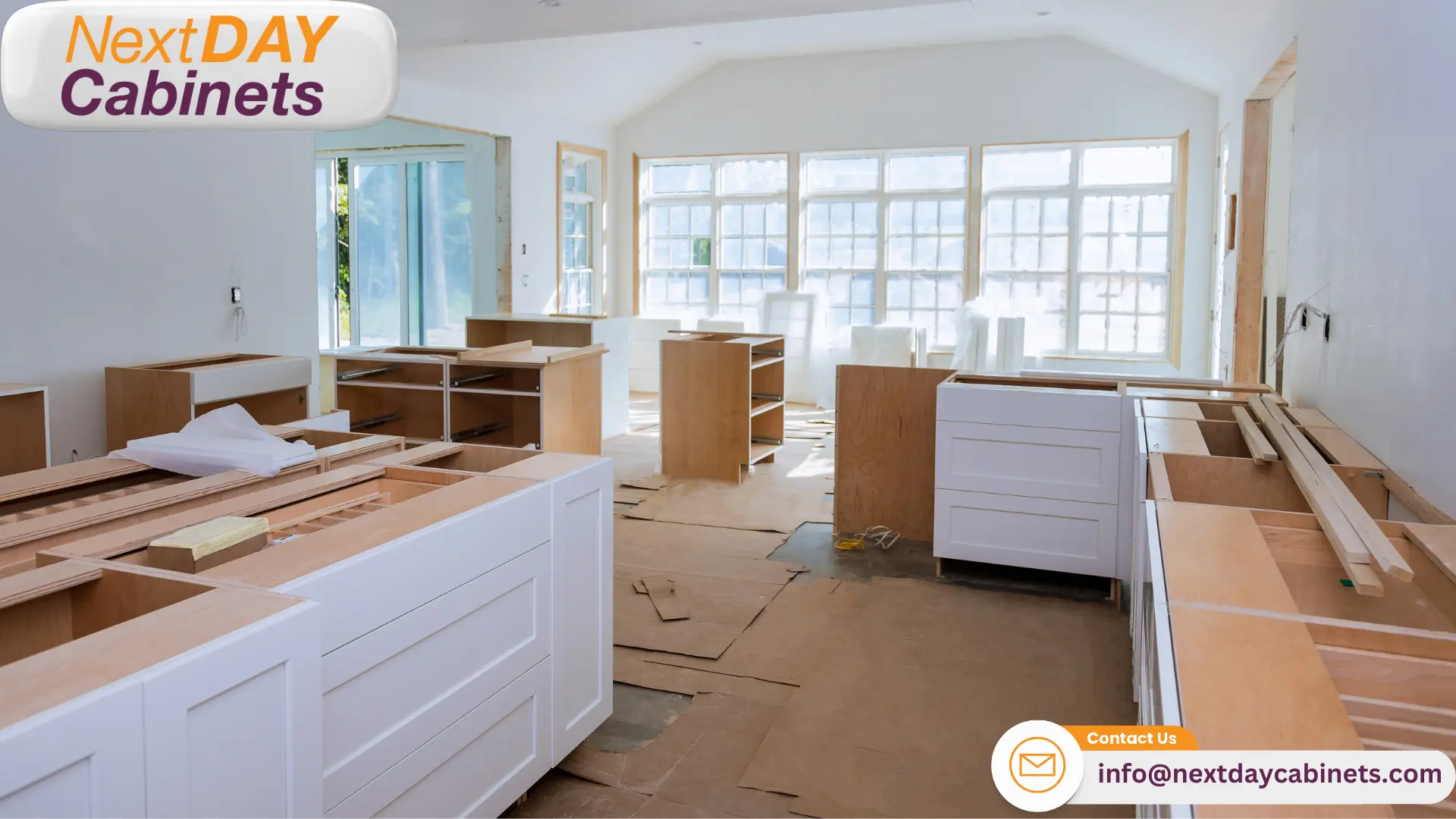
Particleboard: Budget-Friendly Basics
Particleboard offers a budget-friendly substrate for kitchen cabinets, making it an attractive option for homeowners with cost constraints. This engineered wood product comprises wood particles bonded with resin, providing a uniform surface ideal for laminate or melamine finishes. While not as durable as solid wood or plywood, particleboard can still be a practical choice for those seeking to realize their dream kitchen without breaking the bank.
When considering particleboard for cabinet construction, it’s essential to understand its limitations regarding moisture resistance and load-bearing capacity. Interior designers often recommend particleboard for upper cabinets or areas less exposed to water. To enhance its durability, manufacturers may apply protective coatings or use moisture-resistant variants similar to those used with polyethylene terephthalate (PET) laminates. While particleboard may not accept stains like natural wood, it provides a smooth surface for paint or other finishes:
- Cost-effective option for budget-conscious renovations
- Uniform surface ideal for laminate or melamine finishes
- Suitable for upper cabinets and low-moisture areas
- Can be enhanced with moisture-resistant coatings
- Provides a smooth base for painted finishes.
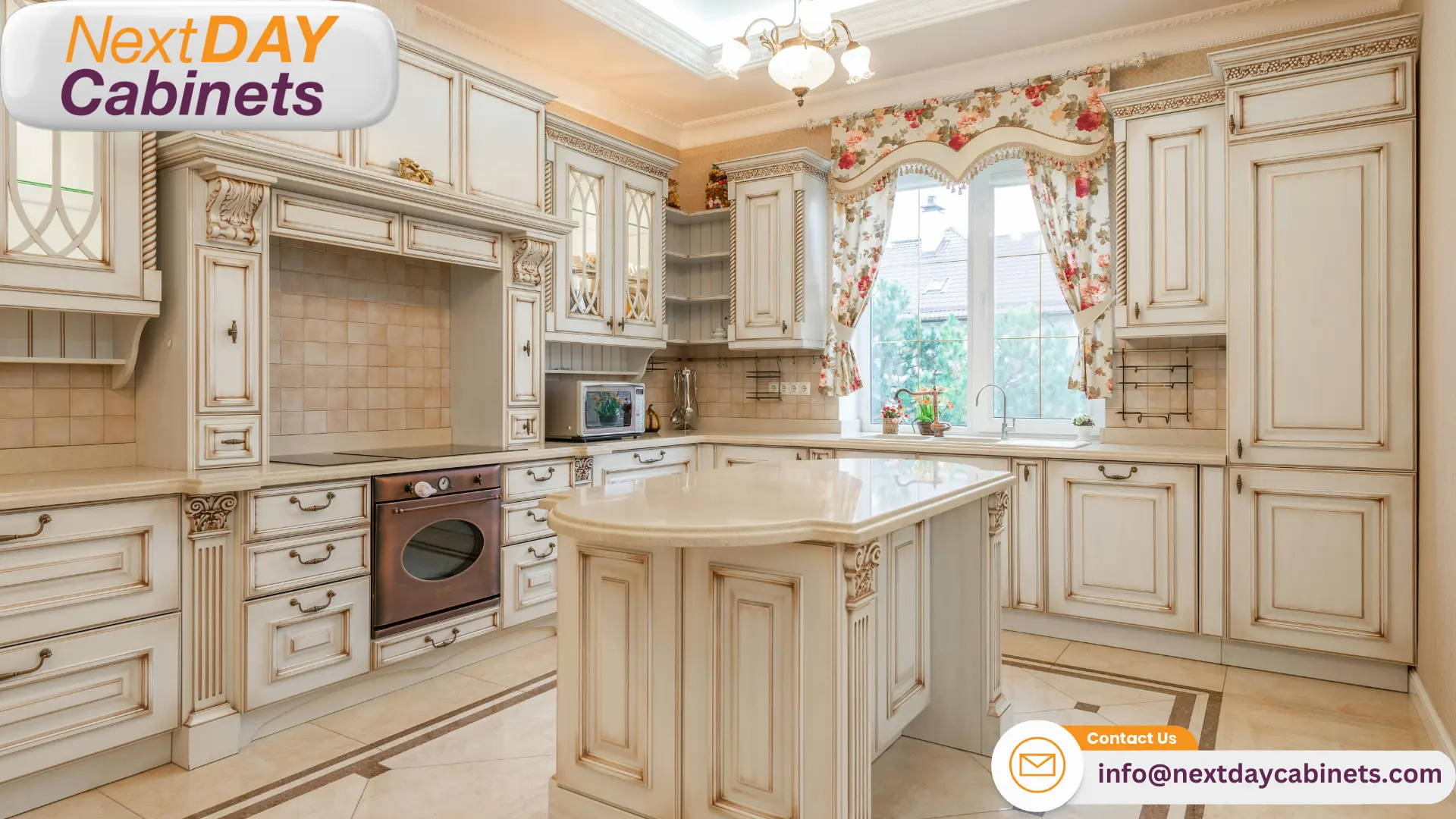
Modern Alternatives: Laminate and Thermofoil Cabinets
Modern alternatives like laminate and thermofoil cabinets offer homeowners cost-effective options for kitchen renovations. These materials provide durability and style comparable to traditional wood cabinets without the need for extensive maintenance or the use of expensive lumber. This section compares laminate and thermofoil cabinets, exploring their durability, cost-effectiveness, and maintenance requirements to help homeowners make informed decisions for their home improvement projects.
Comparing Durability and Style
Laminate and thermofoil cabinets offer distinct advantages in durability and style for modern kitchens. Laminate cabinets, known for their hardness and resistance to wear and tear, provide a wide range of color options and finishes that can mimic the look of natural wood or stone. Their durable surface withstands daily use and is less prone to chipping or scratching than some painted finishes.
While susceptible to heat damage, thermofoil cabinets excel in moisture resistance and ease of cleaning. Their seamless construction eliminates the need for visible hinges, contributing to a sleek, contemporary aesthetic. Both materials offer consistent color and texture throughout, unlike solid wood, which may show variations in grain or sand marks. Homeowners should consider their kitchen‘s exposure to heat and moisture when choosing between these modern alternatives.
Cost-Effectiveness and Maintenance Needs
Laminate and thermofoil cabinets offer cost-effective solutions for homeowners seeking durable kitchen cabinetry
Maintenance for laminate and thermofoil cabinets typically involves simple cleaning with mild soap and water, eliminating the need for specialized products or frequent refinishing. However, homeowners should be cautious of extreme heat near cooking areas and potential moisture issues around plumbing fixtures. When properly maintained, these modern alternatives provide long-lasting performance at a fraction of the cost of solid wood cabinets:
- Easy to clean with mild soap and water
- Resistant to moisture and termites
- No need for specialized maintenance products
- Lower long-term costs compared to wood cabinets
- Caution is required near heat sources and plumbing areas.
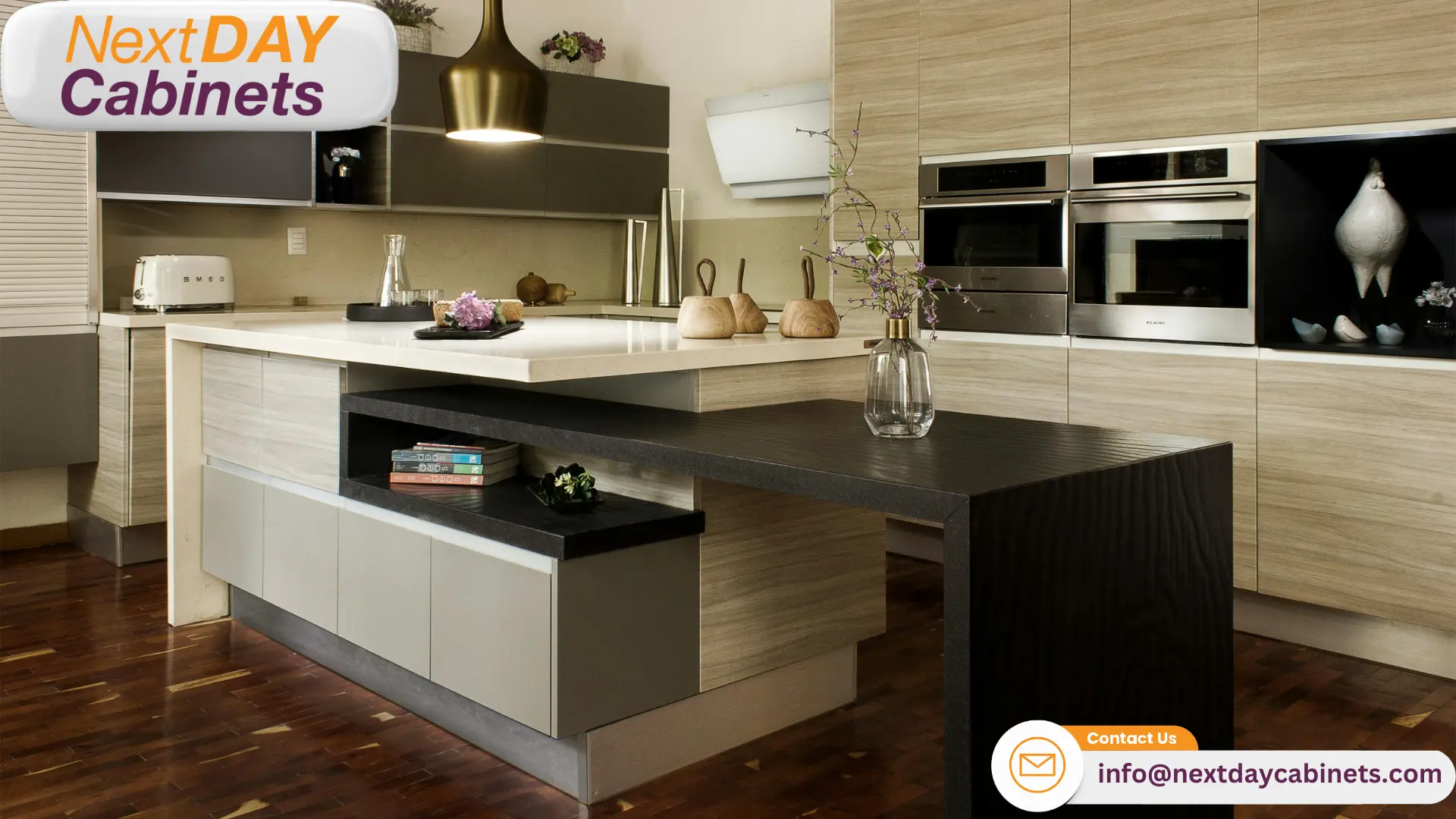
Choosing Between Laminate and Thermofoil
When choosing between laminate and thermofoil cabinets, homeowners should consider their needs and kitchen environment. Laminate cabinets offer superior wear resistance and durability, ideal for high-traffic areas or homes with children. They also provide a more comprehensive range of color and pattern options, including concrete-inspired finishes that can complement modern kitchen designs.
Thermofoil cabinets excel in moisture resistance, making them suitable for areas near sinks or in humid climates. Their seamless construction eliminates visible door edges, creating a sleek appearance that can enhance bedroom vanities or other living spaces. While thermofoil may not be as resistant to wear as laminate, it offers a softer touch. It can be an excellent choice for those seeking a balance between aesthetics and functionality in less demanding environments.
Metal Cabinets: A Sleek, Modern Choice
Metal cabinets, particularly those made from stainless steel and aluminum, offer a sleek, modern choice for kitchens. These materials provide excellent durability and corrosion resistance, making them a worthwhile investment. The following sections explore their appeal, maintenance requirements, and aesthetic considerations, including how they complement glass elements and impact the kitchen design.
The Appeal of Stainless Steel and Aluminum
Stainless steel and aluminum cabinets offer a sleek, modern aesthetic that appeals to homeowners seeking a contemporary kitchen design. These metal options contrast traditional wood cabinets, including real wood cabinets and plywood kitchen elements. Their reflective surfaces make spaces appear larger and brighter, while their durability surpasses MDF cabinet doors or PVC cabinets.
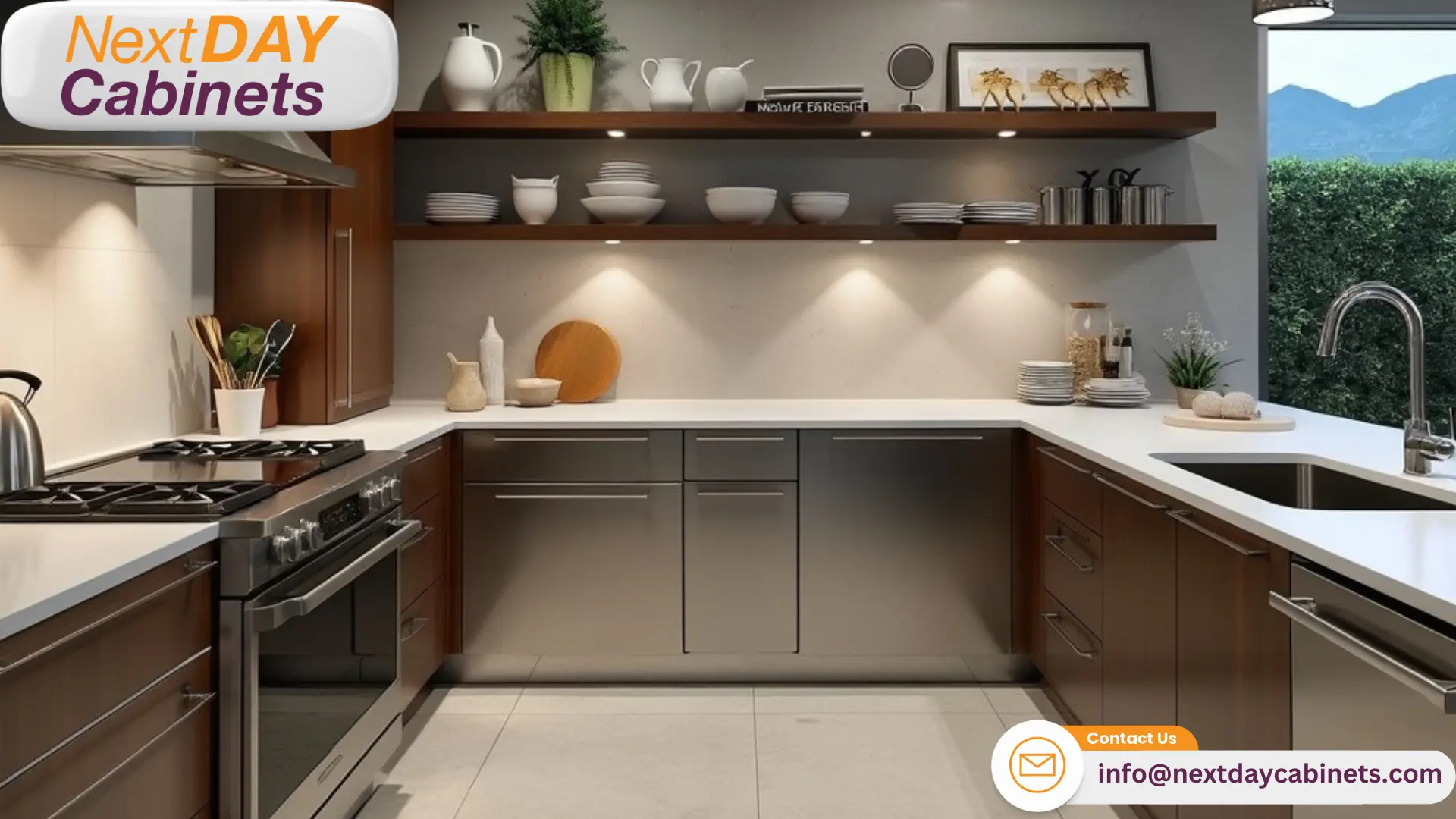
The appeal of metal cabinets extends beyond aesthetics to practical benefits. Stainless steel and aluminum are highly resistant to moisture, heat, and stains, making them ideal for busy kitchens. Unlike cabinet wood material that may warp or deteriorate over time, metal cabinets maintain their appearance and structural integrity for years, offering a long-lasting solution for homeowners:
| Feature | Stainless Steel | Aluminum |
|---|---|---|
| Durability | Excellent | Very Good |
| Weight | Heavy | Lightweight |
| Corrosion Resistance | High | Moderate |
| Cost | Higher | Lower |
Durability, Maintenance, and Aesthetic Considerations
Metal cabinets, particularly those made from aluminum or stainless steel, offer exceptional durability and low maintenance requirements compared to traditional materials like MDF kitchen cabinet doors or PVC cabinets for kitchens. Their resistance to moisture, heat, and stains makes them ideal for high-traffic areas, while their smooth surfaces are easy to clean with simple soap and water solutions. Unlike melamine cabinet doors, metal cabinets do not require sealing or repainting, maintaining their appearance for years with minimal upkeep.
Aesthetically, metal cabinets provide a sleek, modern look that can complement various kitchen styles. The reflective properties of aluminum cabinet doors can enhance lighting and create an illusion of space, making them suitable for smaller kitchens. While some homeowners may find metal cabinets too industrial, combining them with warmer elements like wood countertops or kitchen cabinet laminate accents can create a balanced, contemporary design that appeals to a wide range of tastes.
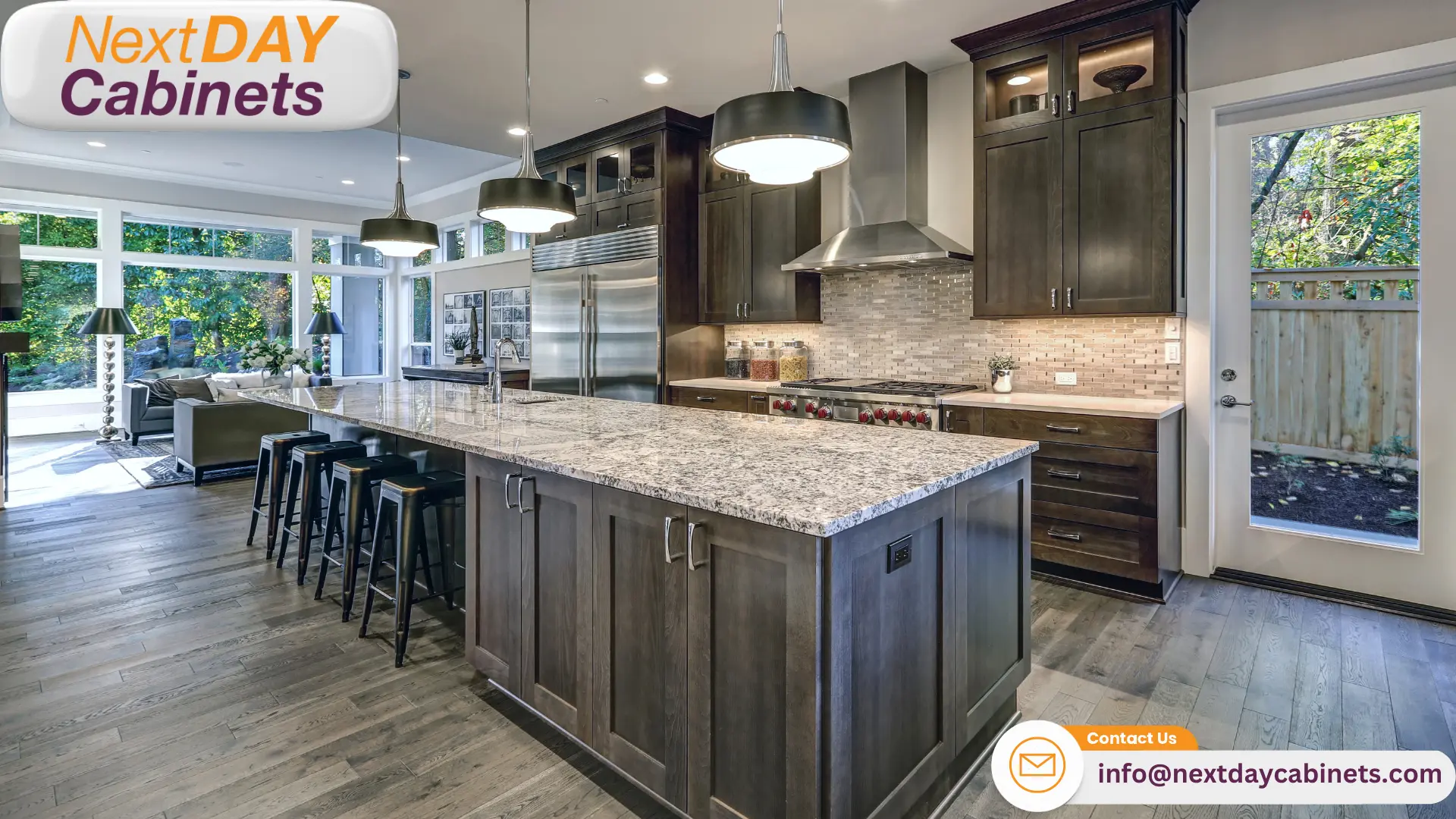
Glass-Front Cabinets: Enhancing Kitchen Aesthetics
Glass-front cabinets offer a unique blend of functionality and style in kitchen design
Combining Functionality and Style
Glass-front cabinets offer a unique combination of functionality and style in modern kitchen designs. By showcasing decorative items or neatly organized dishware, these cabinets add visual interest while maintaining the structural integrity of traditional cabinet materials. Homeowners can integrate glass-front doors with various cabinet materials, such as veneer cabinets or HDF cabinet doors, to create a cohesive look that enhances the kitchen aesthetic.
The versatility of glass-front cabinets extends beyond their visual appeal. They can be incorporated into different cabinet refacing materials to refresh kitchen cabinet boxes. This approach allows for a cost-effective update that combines the durability of traditional cabinet materials with the lightness and elegance of glass elements. By strategically placing glass-front cabinets, homeowners can highlight specific kitchen areas while balancing open and closed storage solutions.
Tips for Using Glass-Front Cabinets Effectively
Effective use of glass-front cabinets begins with strategic placement. Homeowners should consider installing these cabinets in areas where they can showcase attractive dishware or decorative items, such as upper cabinets flanking a kitchen window or above a coffee station. This placement highlights prized possessions and creates visual interest and depth in the kitchen space.
To maintain a cohesive look, homeowners should balance glass-front cabinets with solid doors. A mix of 20-30% glass-front cabinets with the remaining solid doors creates an appealing aesthetic without overwhelming the space. Additionally, incorporating interior cabinet lighting enhances the display effect, drawing attention to the contents and adding a warm ambiance to the kitchen during evening hours.
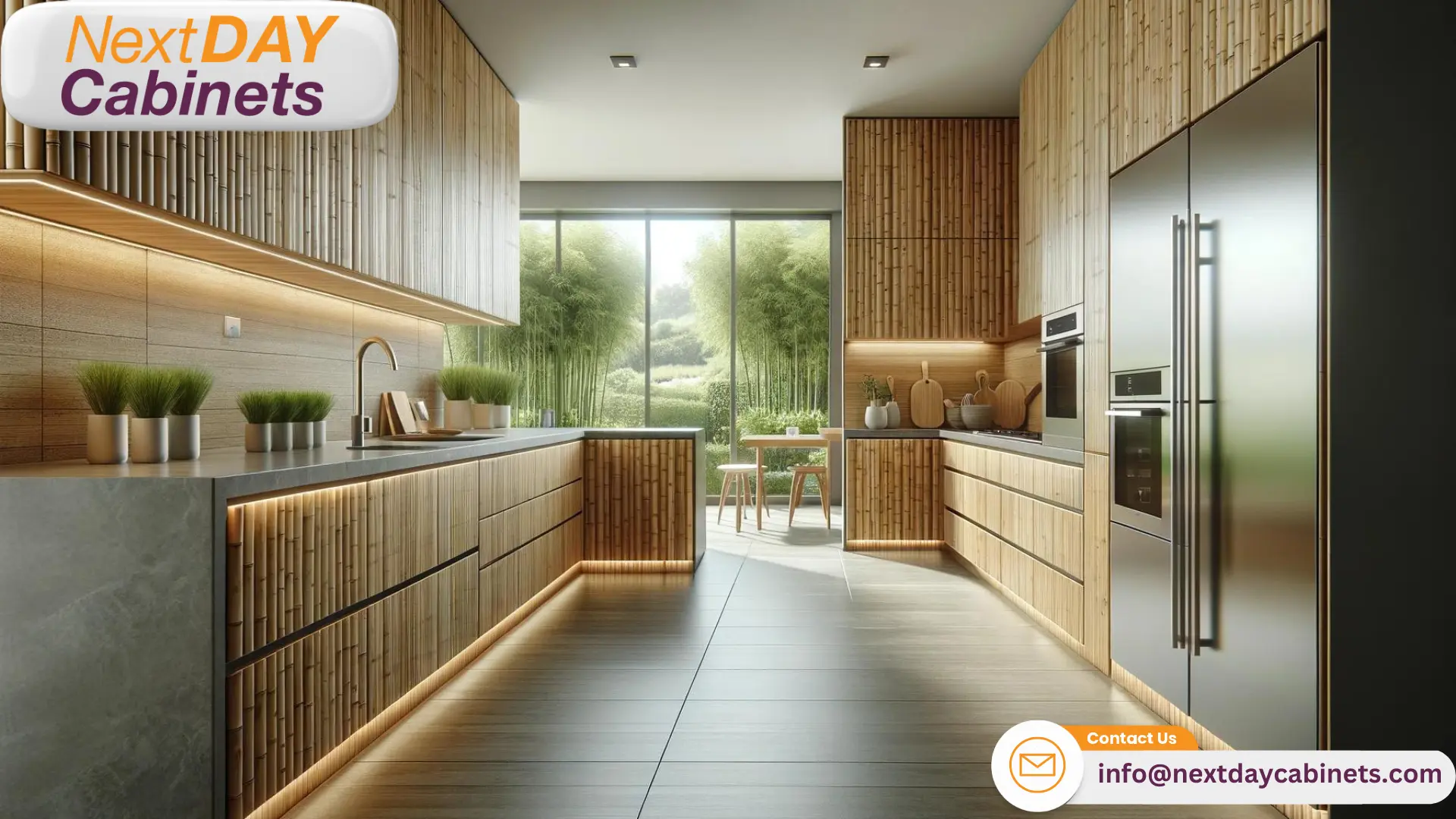
The Rise of Eco-Friendly Kitchen Cabinet Materials
Eco-friendly kitchen cabinet materials are gaining popularity among homeowners seeking sustainable options. This section explores green alternatives like bamboo and reclaimed wood, highlighting their environmental benefits and aesthetic appeal. Sustainable choices offer durability and unique character while reducing environmental impact, making them an attractive option for modern kitchens.
Sustainable Options for Green Homes
Sustainable options for green homes have expanded to include innovative kitchen cabinet materials that prioritize environmental responsibility without compromising on quality or aesthetics. Bamboo, a rapidly renewable resource, has become a popular choice for eco-conscious homeowners. Its fast growth rate and natural durability make it an excellent alternative to traditional hardwoods, offering a unique grain pattern and warm tones that complement various kitchen styles.
Reclaimed wood cabinets present another sustainable option, giving new life to materials that might otherwise end up in landfills. These cabinets reduce the demand for new timber and bring character and history into modern kitchens. Manufacturers have developed techniques to refurbish and treat reclaimed wood, ensuring it meets the same quality standards as new materials while retaining its distinctive appearance and contributing to a more sustainable home environment.
Benefits of Bamboo and Reclaimed Wood Cabinets
Bamboo and reclaimed wood cabinets offer significant environmental benefits while providing durable and aesthetically pleasing options for kitchen design. Bamboo, a rapidly renewable resource, grows quickly and requires minimal processing, reducing its carbon footprint compared to traditional hardwoods. Reclaimed wood cabinets repurpose existing materials, diverting waste from landfills and preserving mature trees, making them an excellent choice for environmentally conscious homeowners.
These eco-friendly materials also bring unique character to kitchen spaces. Bamboo cabinets feature a distinctive grain pattern and light color that brightens kitchens, while reclaimed wood offers rich tones and textures that tell a story through their weathered appearance. Both options provide exceptional durability, with bamboo offering natural resistance to moisture and wear and reclaimed wood demonstrating proven longevity through its previous use. Homeowners can enjoy peace of mind knowing that their cabinetry choices support sustainability without compromising quality or style.
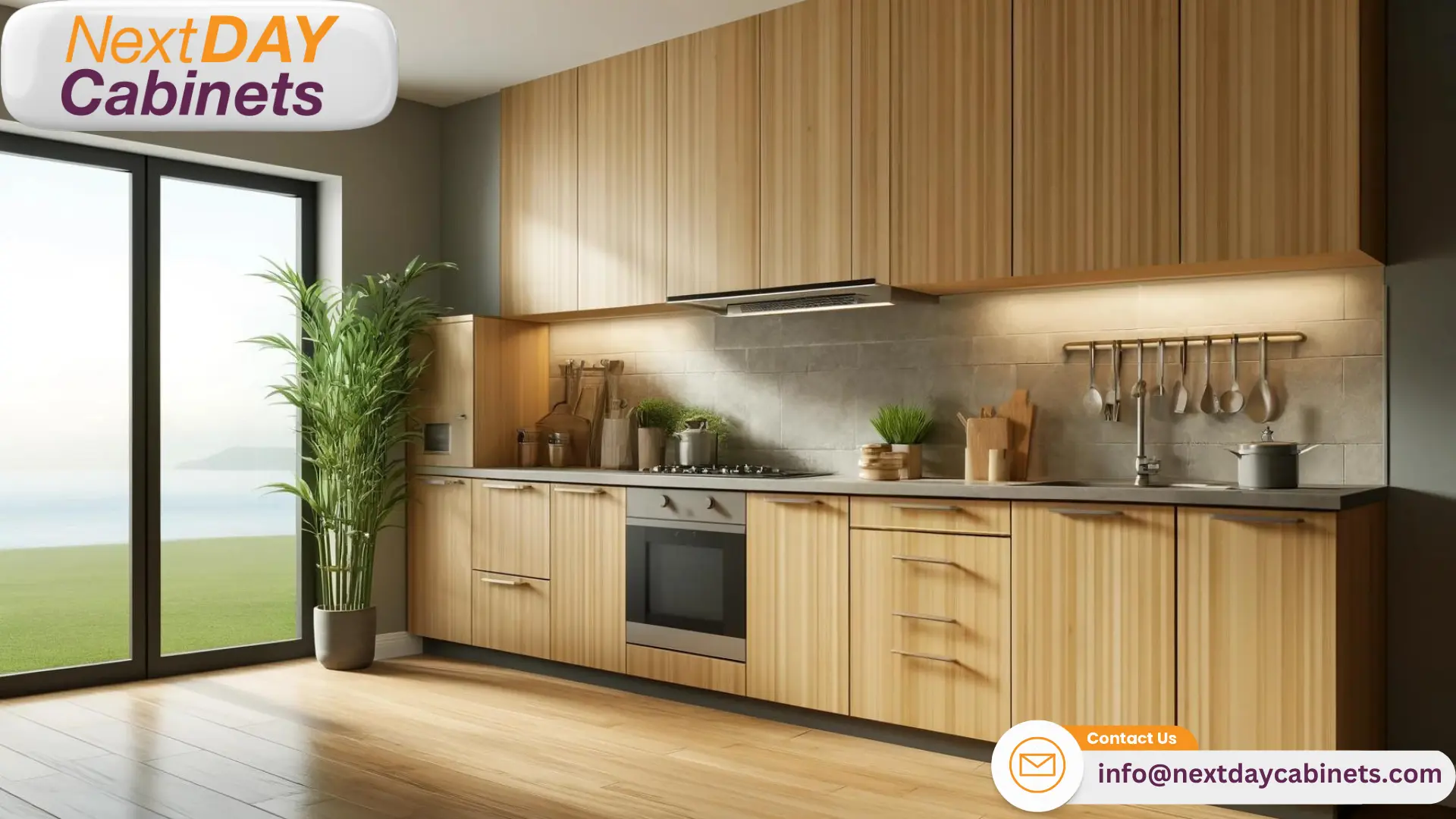
How to Choose the Best Kitchen Cabinet Material for Your Home
Selecting the ideal kitchen cabinet material involves assessing your kitchen‘s needs and style, balancing your budget with aesthetics and functionality, and consulting design experts for custom solutions. This section guides homeowners through these crucial considerations, helping them make informed decisions that align with their specific requirements and preferences for durable, attractive cabinetry.
Assessing Your Kitchen’s Needs and Style
Assessing a kitchen‘s needs and style is crucial when selecting cabinet materials. Homeowners should consider the kitchen‘s layout, traffic patterns, and overall design aesthetic to determine the most suitable options. For instance, a busy family kitchen may benefit from durable materials like solid wood or high-quality laminate that can withstand frequent use and cleaning.
The kitchen‘s style plays a significant role in material selection. Modern kitchens often pair well with sleek materials like stainless steel or high-gloss laminates, while traditional spaces may favor the warmth of natural wood. Homeowners should also consider the kitchen‘s lighting, as some materials, like glass-front cabinets, can enhance brightness and create a more open feel in smaller spaces.
Balancing Budget, Aesthetics, and Functionality
Balancing budget, aesthetics, and functionality is crucial when selecting kitchen cabinet materials. Homeowners should prioritize durability and longevity to ensure their investment withstands daily use. While high-end materials like solid wood or stainless steel offer exceptional quality, budget-friendly options such as laminate or thermofoil can provide attractive alternatives without compromising functionality.
To achieve the desired aesthetic within budget constraints, homeowners can consider mixing materials, such as using solid wood for visible areas and opting for more affordable options for less prominent cabinets. This approach allows for a harmonious blend of style and practicality while maintaining overall kitchen functionality. Additionally, exploring various finishes and hardware options can enhance the appearance of cost-effective materials, creating a custom look that aligns with budget and design preferences.
Consulting With Design Experts for Custom Solutions
Consulting with design experts offers homeowners valuable insights into custom cabinet solutions that balance aesthetics, functionality, and budget. Professional designers can assess the kitchen‘s layout, lighting, and overall style to recommend materials and finishes that complement the space while meeting specific needs. Their expertise helps homeowners navigate the vast array of options, from traditional wood to modern composites, ensuring a cohesive design that aligns with the home’s architecture and the family’s lifestyle.
Design experts also provide access to a broader range of materials and innovative solutions that may not be readily available to the general public. They can suggest unique combinations of materials or custom finishes that create a truly personalized kitchen. Additionally, their knowledge of current trends and timeless designs helps homeowners make choices that will remain stylish and functional for years. Collaboration with design professionals often results in more efficient use of space and creative storage solutions, maximizing the kitchen‘s potential:
| Benefits of Consulting Design Experts | Impact on Cabinet Selection |
|---|---|
| Access to unique materials | Personalized aesthetic options |
| Knowledge of current trends | Long-lasting style choices |
| Space optimization expertise | Efficient storage solutions |
| Understanding of home architecture | Cohesive overall design |
Common Mistakes to Avoid When Selecting Cabinet Material
When selecting kitchen cabinet materials, homeowners often make critical errors impacting durability, cost-effectiveness, and overall design harmony. This section highlights common pitfalls to avoid, including overlooking maintenance requirements, compromising quality for lower costs, and neglecting compatibility with existing kitchen aesthetics. Understanding these potential missteps helps ensure a more informed and satisfying cabinet selection process.
Overlooking Durability and Maintenance
Homeowners often need to pay more attention to durability and maintenance requirements when selecting kitchen cabinet materials. This oversight can lead to premature wear and tear, especially in high-traffic areas or homes with young children. For instance, while laminate cabinets may offer an attractive, budget-friendly option, they can be more susceptible to chipping and moisture damage than solid wood or high-quality plywood alternatives.
Neglecting to consider long-term maintenance needs can result in unexpected costs and inconvenience. Some materials, such as natural wood, may require periodic refinishing or sealing to maintain their appearance and protect against moisture. In contrast, engineered wood products or metal cabinets often offer lower maintenance solutions, potentially saving time and money over the kitchen’s lifespan. Homeowners should carefully weigh these factors to ensure their chosen cabinet material aligns with their lifestyle and maintenance preferences.
Compromising on Quality for Cost
When selecting kitchen cabinet materials, homeowners must prioritize initial cost savings over long-term quality. While budget-friendly options like particleboard or low-grade MDF may seem attractive initially, they can lead to higher expenses in the long run due to their susceptibility to moisture damage and wear. These materials may require frequent replacement or repairs, ultimately costing more than investing in higher-quality options.
Opting for superior materials such as solid wood, high-grade plywood, or premium laminates can provide better durability and longevity, even if they come at a higher upfront cost. These materials often offer better resistance to daily wear, moisture, and temperature fluctuations, maintaining their appearance and structural integrity for years. Homeowners should consider the total cost of ownership, including potential maintenance and replacement expenses when evaluating cabinet material options to make a more informed decision that balances quality and cost-effectiveness.
Ignoring Compatibility With Kitchen Design
Ignoring compatibility with kitchen design is a common mistake homeowners need to make when selecting cabinet materials. They often choose materials based solely on personal preference or trend and must consider how they will harmonize with the existing kitchen elements. This oversight can lead to a disjointed appearance, where cabinets clash with countertops, flooring, or appliances, disrupting the overall aesthetic.
To avoid this pitfall, homeowners should consider their kitchen‘s style, color scheme, and architectural elements when selecting cabinet materials. For instance, modern kitchens with sleek lines may benefit from high-gloss laminates or metal finishes, while traditional spaces might be better suited to natural wood grains. Consulting with a design professional can help ensure cabinet materials complement the kitchen‘s design, creating a cohesive and visually appealing space. Consider the following factors when assessing compatibility:
- Existing color palette and materials
- Kitchen layout and architectural features
- Lighting conditions and their effect on material appearance
- Overall design style (e.g., modern, traditional, transitional)
- Long-term design plans for the home.
Top Trends in Kitchen Cabinet Materials for 2024
Kitchen cabinet trends for 2024 focus on innovative materials that combine durability with cutting-edge design. This section explores advancements in material technology, enhancing both functionality and aesthetics. It also examines the rise of eco-friendly and high-tech materials, reflecting growing consumer demand for sustainable and smart kitchen solutions.
Innovations in Material Durability and Design
Recent innovations in kitchen cabinet materials have significantly improved durability and design
Design innovations have led to the development of ultra-thin materials that mimic the look of natural stone or wood while offering superior strength and versatility. These materials allow for sleeker cabinet profiles and seamless integration with smart home technologies, such as touch-sensitive opening mechanisms and built-in lighting systems. As a result, homeowners can now achieve a high-end aesthetic with improved functionality and durability.
Emerging Eco-Friendly and High-Tech Materials
Eco-friendly materials are gaining prominence in kitchen cabinet design, with manufacturers introducing innovative options that minimize environmental impact. Recycled plastics, agricultural waste products, and rapidly renewable resources like bamboo are transforming into durable, attractive cabinet materials. These sustainable alternatives allow homeowners to reduce their carbon footprint without compromising style or functionality.
High-tech materials are revolutionizing kitchen cabinet design
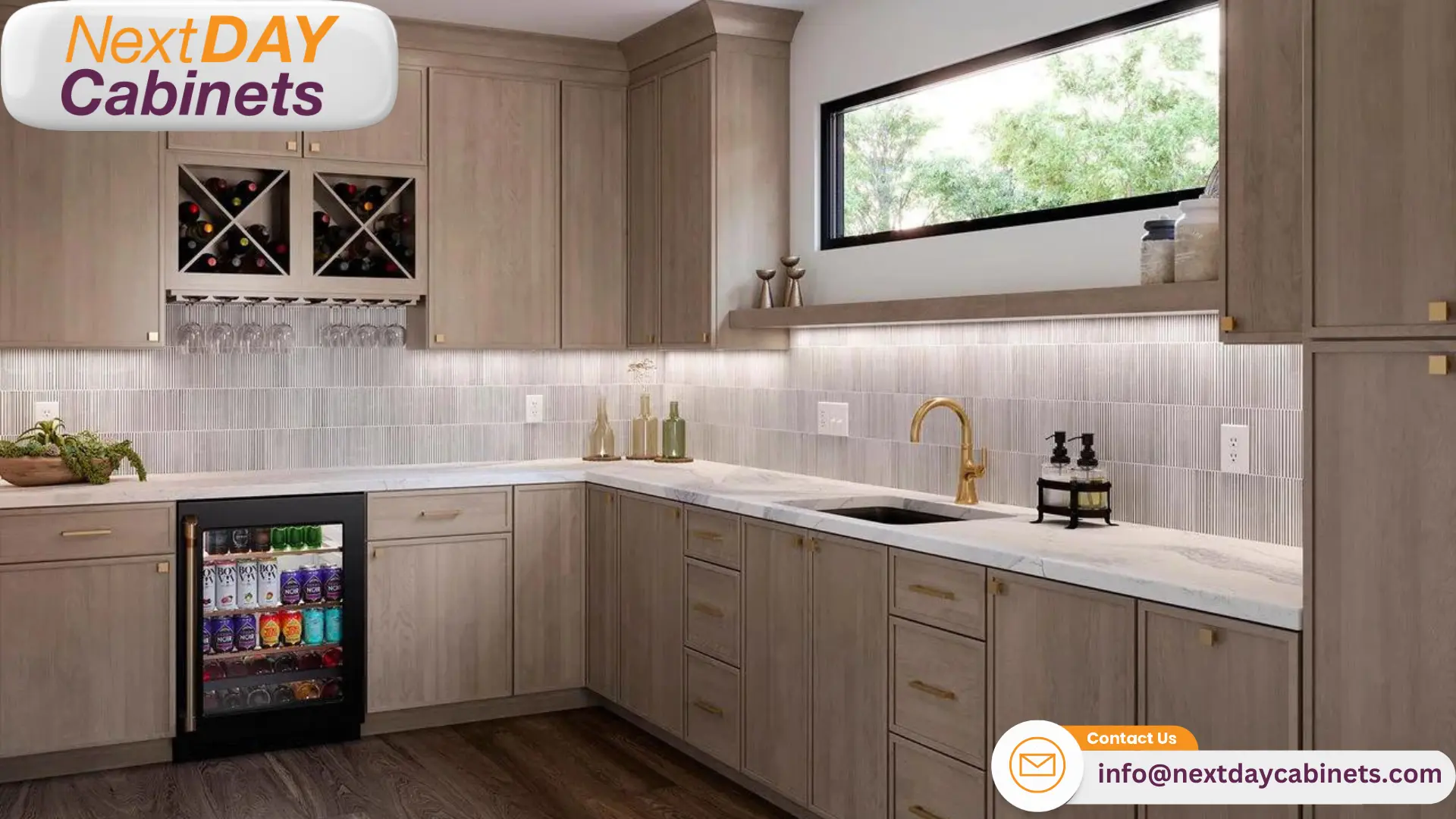
FAQs for Choosing the Right Kitchen Cabinet Material
What color cabinets never go out of style?
Neutral tones like white, gray, and beige remain timeless choices for kitchen cabinets. These colors are incredibly versatile, complementing a variety of kitchen cabinet materials such as solid wood, laminate, and engineered wood. White cabinets, in particular, offer a classic, clean aesthetic that never feels outdated. They also provide a neutral backdrop for bold accents or more adventurous wall colors.
Another color gaining attention for its long-term appeal is navy blue, which adds sophistication without overwhelming the space. If you’re considering more modern alternatives, charcoal or black kitchen cabinets also deliver a sleek, elegant look that endures over time, especially in contemporary designs.
Ultimately, choosing a color that pairs well with the durability, moisture resistance, and aesthetics of the kitchen cabinet material will ensure that your choice remains stylish for years.
What are melamine kitchen cabinets made of?
Melamine kitchen cabinets are crafted from a core of engineered wood, often MDF (Medium-Density Fiberboard) or particleboard, coated with a layer of melamine resin. This resin is durable and moisture-resistant, making it a popular surface finish for cabinets.
The outer melamine layer can come in various colors and finishes, including matte, glossy, or textured surfaces, allowing for diverse aesthetic possibilities. Melamine cabinets are favored for their affordability, ease of maintenance, and modern designs. However, while the surface is resistant to scratches and stains, the core material may not be as robust as solid wood or plywood, particularly in humid environments.
What is the best material for kitchen cabinets?
The best kitchen cabinet material depends on your priorities, including durability, aesthetics, and budget. Here are some of the most popular materials:
- Solid Wood: Timeless and durable, solid wood is known for its natural beauty and long-lasting quality. It’s a great option if you’re looking for a classic, high-end feel. However, it requires more maintenance and is sensitive to moisture.
- Plywood: A highly durable and affordable option, plywood consists of multiple layers of wood veneer glued together, making it more resistant to warping and moisture than solid wood.
- MDF (Medium-Density Fiberboard): MDF is an engineered wood that offers a smooth, even surface for painted finishes. It’s more affordable than solid wood and resists cracking and warping, but it may not be as sturdy as plywood.
- Stainless Steel: Ideal for a sleek, modern kitchen, stainless steel kitchen cabinets are highly durable, heat-resistant, and easy to clean. They’re often used in commercial kitchens but are increasingly popular in residential settings for their contemporary appeal.
- Eco-Friendly Materials: Bamboo and reclaimed wood are excellent choices for those seeking sustainable options. They offer unique textures and patterns while promoting environmental responsibility.
Choosing the best material involves weighing these factors and possibly seeking guidance from design experts to match the material with your kitchen’s overall design.
What makes a good kitchen cabinet?
A good kitchen cabinet is the perfect balance of durability, aesthetics, and functionality. Here are the key features to look for:
- Durability: High-quality kitchen cabinets are made from robust materials like solid wood, plywood, or even stainless steel. They should resist moisture, scratches, and warping, especially in a busy kitchen environment. Cabinet doors and drawers should have soft-close mechanisms for longevity.
- Aesthetics: Your kitchen cabinets should complement your overall kitchen style. For example, thermofoil cabinets provide a sleek, modern look, while solid wood offers a more traditional and warm appearance.
- Ease of Maintenance: The best kitchen cabinet materials are easy to clean and maintain. Laminate and thermofoil are excellent choices for their stain-resistant and wipe-clean surfaces, while stainless steel provides hassle-free maintenance in modern kitchens.
- Customization: Opt for cabinets tailored to your needs, including adjustable shelving and custom storage solutions. Customizing ensures your kitchen is both beautiful and practical.
Are stainless steel kitchen cabinets durable?
Yes, stainless steel kitchen cabinets are incredibly durable and often favored in commercial kitchens. They resist heat, stains, and corrosion, making them an ideal choice for those who prioritize longevity and ease of maintenance.
In terms of aesthetics, stainless steel offers a modern, industrial look that suits contemporary or minimalist kitchen designs. The sleek surface is easy to clean but may show fingerprints or scratches more easily than wood or other materials. However, this can be mitigated with special finishes or proper care.
Stainless steel cabinets are also resistant to moisture and humidity, making them an excellent choice for kitchens prone to spills and high moisture. They are a long-lasting, eco-friendly kitchen cabinet material requiring minimal upkeep.
Which quality is best for kitchen cabinets?
The “best” kitchen cabinet material depends on your priorities. Solid wood is a classic choice for durability and aesthetics, offering timeless beauty and lasting strength. However, it’s also the most expensive option. Engineered wood like plywood and MDF offers excellent durability and moisture resistance at a more affordable price. Modern alternatives like bamboo and reclaimed wood provide eco-friendly options with unique aesthetics. Ultimately, the best choice depends on your budget, design preferences, and desired maintenance level.
How can you tell cheap cabinets?
Cheap cabinets often use lower-quality materials like laminate or thermofoil, which can be prone to scratches and damage. They may also have flimsy construction with thin panels and weak hinges. Look for solid wood or engineered wood like plywood for better quality and durability. Also, pay attention to the cabinet doors – they should be solid and well-constructed, not flimsy or hollow.
What are the three grades of cabinets?
There isn’t a standardized “grading” system for kitchen cabinets. However, you can generally categorize them based on material and construction:
- Entry-level: Typically made from laminate or thermofoil over MDF or particleboard. They offer affordability but may lack durability and aesthetic appeal.
- Mid-range: Often use engineered wood like plywood or MDF with wood veneer or laminate finishes. They provide a balance of affordability, durability, and aesthetics.
- High-end: Made from solid wood like oak, maple, or cherry. They offer the highest durability and aesthetic appeal but have a higher price tag.
What color kitchen cabinets sells best?
The “best” cabinet color is subjective and depends on current trends and personal preferences. However, white cabinets remain popular for their timeless appeal and ability to brighten any kitchen. Gray cabinets are also trending for their versatility and ability to complement various design styles. Ultimately, choose a color that complements your existing decor and personal taste.
Should cabinets be lighter or darker than walls?
There’s no hard-and-fast rule, but generally, contrasting colors create visual interest. If your walls are light, darker cabinets can add depth and dimension. Conversely, lighter cabinets can brighten the space if your walls are dark. Consider your personal preferences and the overall aesthetic you’re trying to achieve.
What is the most popular cabinet color for 2024?
While white cabinets remain a classic choice, warm neutrals
What are premium cabinets made of?
Premium kitchen cabinets are typically made of high-quality solid wood materials such as oak, maple, cherry, or walnut. These cabinet materials offer exceptional durability, a luxurious appearance, and long-lasting performance. However, modern alternatives like high-end engineered wood or eco-friendly materials like bamboo and reclaimed wood are also gaining popularity among design experts for premium cabinet construction. The choice often depends on the homeowner’s desired aesthetics, budget, and specific requirements.
What are the most durable kitchen cabinets made of?
The most durable kitchen cabinets are made from solid wood or high-quality plywood. Solid wood cabinets, particularly those made from hardwoods like oak or maple, offer excellent durability and can last decades with proper care. Plywood, an engineered wood product, is also highly durable and resistant to warping and moisture damage. For those seeking modern alternatives, stainless steel cabinets are durable and resistant to heat, moisture, and stains. The choice of cabinet materials significantly impacts their longevity and ability to withstand daily wear and tear in a busy kitchen environment.
What is a cost-effective material for kitchen cabinets?
For homeowners on a budget, several cost-effective kitchen cabinet materials must be considered. Medium-Density Fiberboard (MDF) is an affordable engineered wood option that offers good durability and a smooth surface for painting. Laminate cabinets are another budget-friendly choice, providing a wide range of colors and patterns at a lower cost than solid wood. Thermofoil, a vinyl material heat-sealed over MDF, is also an economical option that mimics the look of painted wood. While these materials may not have the same longevity as solid wood, they can still provide attractive and functional cabinets at a more accessible price point.
Is it cheaper to buy or build kitchen cabinets?
In most cases, buying pre-made kitchen cabinets is more cost-effective than building custom cabinets from scratch. Ready-to-assemble (RTA) cabinets, like those offered by NextDay Cabinets, balance quality and affordability. These cabinets are mass-produced, reducing costs but providing various styles and materials. Building custom cabinets requires specialized skills, tools, and more time, which can significantly increase the overall cost. However, building cabinets might be worthwhile if you have unique space requirements or desire specific custom features. It’s best to consult design experts to determine the most suitable and cost-effective solution for your needs.
How to get new kitchen cabinets on a budget?
There are several strategies to get new kitchen cabinets on a budget:
- Choose cost-effective materials: Opt for budget-friendly cabinets like MDF, laminate, or thermofoil instead of expensive solid wood options.
- Consider ready-to-assemble (RTA) cabinets: Companies like NextDay Cabinets offer affordable RTA options that you can assemble, saving labor costs.
- Explore stock cabinets. These pre-made cabinets come in standard sizes and finishes and are often lower priced than semi-custom or custom options.
- Mix and match: Use higher-end materials for visible areas and more affordable options for less noticeable spaces.
- Reface or refinish existing cabinets: If your cabinet boxes are in good condition, refacing or refinishing can give them a new look at a fraction of the cost of replacement.
- Look for sales and discounts: Look for promotions, especially during holiday seasons or end-of-year sales.
- Consider open shelving: Replacing some upper cabinets with open shelves can reduce costs while adding a modern touch to your kitchen.
- Work with a professional designer: They can help you maximize your budget and find creative solutions that balance cost and quality.
What is the best material to use for kitchen cabinets?
The best kitchen cabinet material depends on your needs, including durability, aesthetics, and budget. Solid wood is often considered the top choice for its beauty and longevity, providing a decades-long classic look. Engineered wood options like plywood and MDF (Medium-Density Fiberboard) are also popular due to their cost-effectiveness and versatility. Plywood offers excellent moisture resistance and durability, making it suitable for kitchen environments, while MDF provides a smooth surface that is ideal for painting. For those seeking modern alternatives, stainless steel and eco-friendly materials like bamboo or reclaimed wood are gaining traction for their unique aesthetics and sustainability.
What is better: MDF or wood for kitchen cabinets?
When comparing MDF and solid wood, the choice largely hinges on your priorities. MDF is more affordable and provides a smooth surface for painting, making it an excellent option for custom finishes. However, it is less durable than solid wood and can swell when exposed to moisture. Solid wood cabinets, while more expensive, offer superior durability and a timeless aesthetic that can enhance the value of your home. Solid wood is generally recommended for high-traffic areas like kitchens due to its strength and resistance to wear.
What material is best for built-in cabinets?
Plywood is often regarded as the best material for built-in cabinets due to its strength and resistance to warping. It can support heavy loads and withstand humidity fluctuations better than particle board or MDF. Additionally, solid wood can be used for a more luxurious finish but may require more maintenance. If aesthetics are a priority, consider using hardwood veneers over plywood to achieve a high-end look without the total cost of solid hardwood.
What are high-end kitchen cabinets made of?
High-end kitchen cabinets are typically crafted from solid hardwoods such as maple, oak, or cherry. These materials provide exceptional durability and lend an elegant appearance that enhances the kitchen design. Custom solutions often incorporate unique finishes, intricate joinery, and high-quality hardware. Some luxury brands may use specialty materials like exotic woods or metal accents to create a distinctive look.
What are most builder-grade cabinets made of?
Builder-grade cabinets are commonly constructed from lower-cost materials like particle board or melamine-coated MDF. These materials are cost-effective but may need more durability and aesthetic appeal than higher-quality options. While they can be suitable for budget-conscious projects, they often do not hold up well over time compared to plywood or solid wood alternatives.
What is the most expensive cabinet material?
The most expensive cabinet materials typically include exotic hardwoods like mahogany or teak, prized for their beauty and rarity. Custom cabinetry made from these woods can significantly increase costs due to the material price and the craftsmanship involved in creating bespoke designs. Other high-end options include stainless steel or custom finishes that utilize luxury materials.
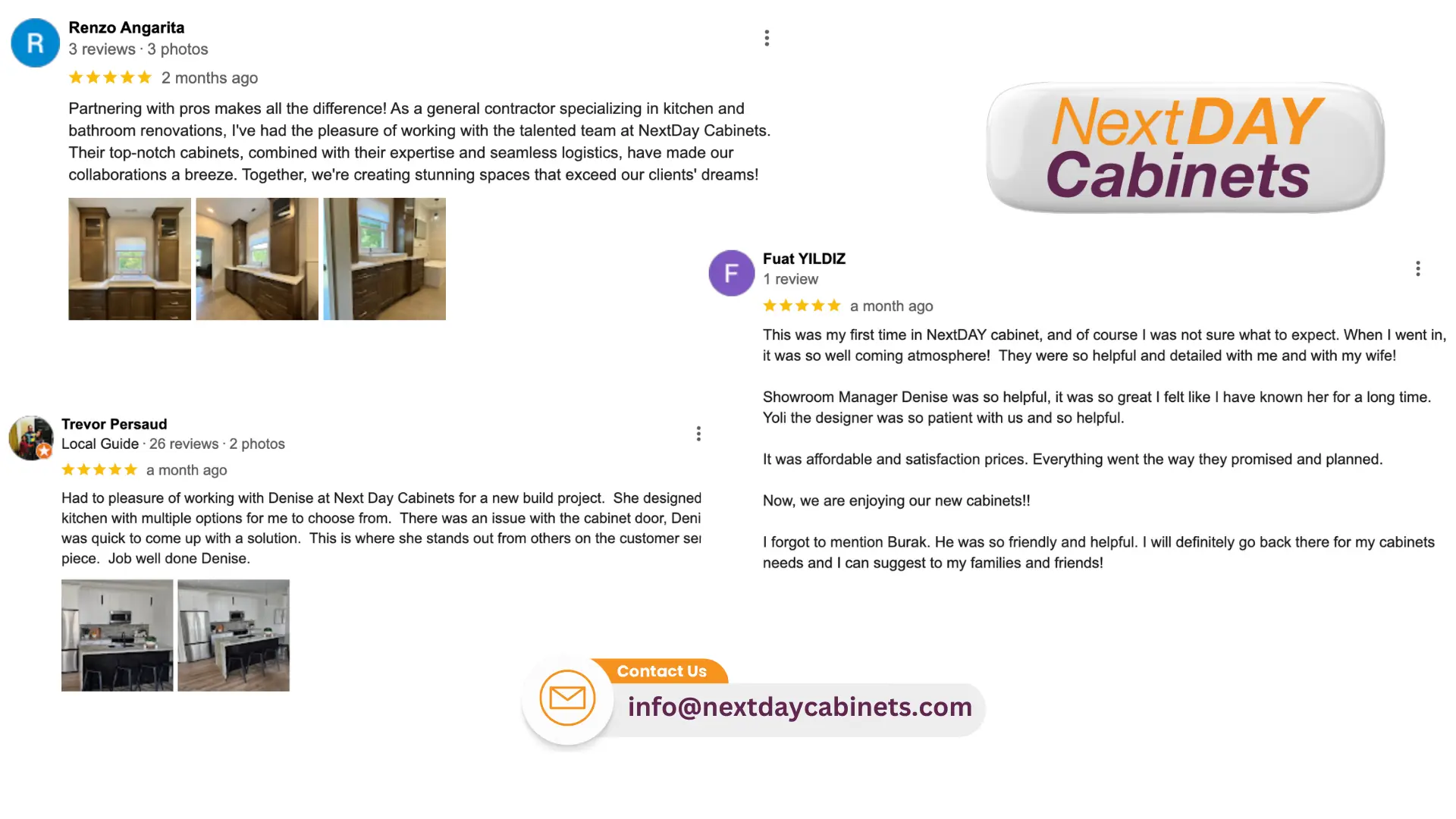
Hear from Our Delighted Clients About Kitchen Cabinet Material
Renzo Angarita, Professional General Contractor
Renzo Angarita, a general contractor specializing in kitchen and bathroom renovations, highly recommends NextDay Cabinets for their professional partnerships. He praises the company for their top-notch cabinets, expertise, and seamless logistics, which have made collaborations effortless. Renzo emphasizes how working together with NextDay Cabinets results in stunning spaces that exceed clients’ expectations.
Trevor Persaud, New Build Project Client
Trevor Persaud commends Denise at NextDay Cabinets for her outstanding work on his new build project. He highlights Denise’s design skills, offering multiple kitchen options to choose from. Trevor particularly appreciates Denise’s quick problem-solving abilities when an issue arose with a cabinet door, underscoring her exceptional customer service.
Fuat YILDIZ, First-Time Customer
As a first-time customer, Fuat YILDIZ shares his excellent experience with NextDay Cabinets. He praises the welcoming atmosphere and the helpful, detailed assistance provided to him and his wife. Fuat specifically mentions Showroom Manager Denise for her exceptional helpfulness, designer Yoli for her patience, and Burak for his friendliness. He emphasizes the affordability, satisfaction with pricing, and the company’s ability to deliver as promised.
Choose NextDay Cabinets for your wholesale cabinet needs and experience the same level of satisfaction as Renzo Angarita, Trevor Persaud, and Fuat YILDIZ. Our dedicated team excels in providing high-quality cabinets, offering expert design assistance, and ensuring customer satisfaction across various projects.
From professional partnerships with contractors to first-time customers, we pride ourselves on our attentive service, design expertise, and commitment to meeting deadlines. Our team, including standout members like Denise, Yoli, and Burak, is known for their competence, patience, and willingness to go the extra mile for our customers.
At NextDay Cabinets, you’ll find a wide range of beautiful cabinet options with competitive pricing, making us the go-to choice for homeowners, industry professionals, and contractors. Our quality focus, knowledgeable staff, and customer-first approach ensure that your cabinet selection and installation process will be smooth and satisfying.
Whether you’re a general contractor looking for a reliable partner, planning a new build project, or a homeowner renovating your kitchen or bathroom, NextDay Cabinets is committed to exceeding your expectations with our product quality, design services, and outstanding customer support. We stand behind our products and are dedicated to resolving any issues that may arise, ensuring your complete satisfaction.
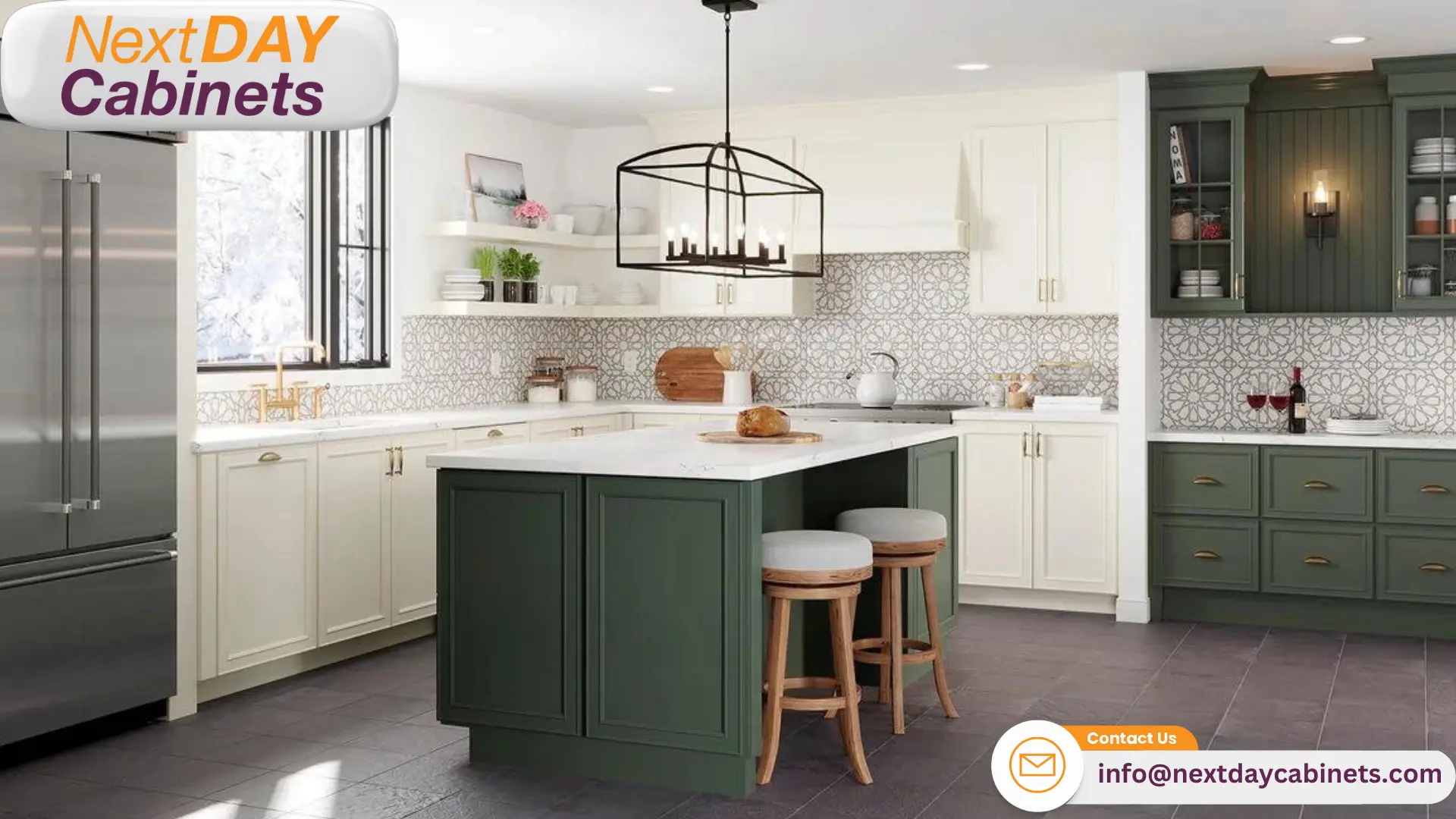
Transform Your Home with NextDAY Cabinets
NextDay Cabinets offers a wide range of high-quality kitchen cabinets and bathroom vanities at affordable prices. As the Mid-Atlantic’s best cabinet wholesaler, we serve six locations: Chantilly, Alexandria, Woodbridge, Richmond, Beltsville, and Chicago.
Visit Our Showrooms
- Chantilly Showroom: 14000 Thunderbolt Pl Suite K, Chantilly, VA 20151
- Alexandria Showroom: 5655 General Washington Dr., Suite E, Alexandria, VA 22312
- Woodbridge Showroom: 3099 PS Business Center Dr, Woodbridge, VA 22192
- Richmond Showroom: 3985 Deep Rock Rd, Richmond, VA 23233
- Beltsville Showroom: 5801 Ammendale Rd, Beltsville, MD 20705
- Chicago Showroom: 1801 Estes Ave, Elk Grove Village, IL 60007
Why Choose NextDAY Cabinets?
- Guaranteed Lowest Price: We ensure customer happiness and loyalty by providing top-quality construction at low factory-direct prices.
- Fast Lead Times: We offer some of the fastest lead times in the industry, with many orders ready in just 3-5 days.
- Professional Design Services: Our experienced design consultants help you create the perfect kitchen for your needs.
- High-Quality Products: All our cabinets are made from 100% solid wood and are KCMA certified, ensuring durability and environmental safety.
NextDAY Cabinets offers the best American made cabinet brands like:
Crestwood, Decora, Forevermark Cabinetry, Mantra, Marsh, Nations Cabinetry, Waypoint, WellKraft Cabinetry, Wolf Home Product in Mid-Atlantic area with 6 showrooms in Chantilly, Alexandria, Woodbridge, Richmond, Beltsville, and Chicago. Check out the exciting cabinets with a wide range of kitchen cabinet material options at NextDAY Cabinets now!
Contractors, Dealers, and Builders! Are You Ready to Transform Homes? Become a dealer now!
Visit our Gallery now! Contact us and start your journey toward modern homes today.
Conclusion
Selecting the ideal kitchen cabinet material requires careful consideration of durability, aesthetics, and budget. Homeowners must balance these factors to find a solution that meets their needs and complements their kitchen design.
Modern alternatives like engineered wood, laminate, and metal offer diverse options for those seeking a balance between cost and performance. These materials provide durability and style comparable to traditional wood cabinets, often at a more accessible price point.
Eco-friendly materials are gaining popularity, reflecting growing consumer awareness of sustainability. Bamboo and reclaimed wood present attractive options for environmentally conscious homeowners, combining unique aesthetics with reduced environmental impact.
Ultimately, the best cabinet material choice depends on individual priorities and kitchen requirements. Consulting with design experts and avoiding common pitfalls can lead to a more informed decision, resulting in cabinets that enhance both the functionality and appeal of the kitchen space:
| Material Type | Key Benefits | Considerations |
|---|---|---|
| Solid Wood | Durability, Classic Appeal | Higher Cost, Maintenance |
| Engineered Wood | Cost-Effective, Versatile | Moisture Sensitivity |
| Laminate/Thermofoil | Affordable, Low Maintenance | Less Durable Than Wood |
| Metal | Modern Look, Durability | Higher Cost, Limited Styles |
| Eco-Friendly | Sustainability, Unique Aesthetic | Availability, Cost Variation |
